- 0 No item in your cart
- The magazine

Current issue
- All the issues
- My magazines
- Technical specifications
- Multihull of the Year
- Classified Ads
- Destinations
- Online store
- All the magazines
- Subscriptions
- Accessories

Catamaran basics The daggerboards: understanding and adjusting them
Having a catamaran with daggerboards means enjoying better pointing ability than an equivalent model equipped with fixed stub keels, which are inevitably shorter. It means that you can also optimize drag, speed and even safety. Partially integrated, with foils...an inventory of the daggerboards on our boats and how to use these appendages.
Create a notification for Technical
We will keep you posted on new articles on this subject.

Published 01/04/2015
By Emmanuel van Deth
Published: may / june 2015

Choose the option that suits you best!
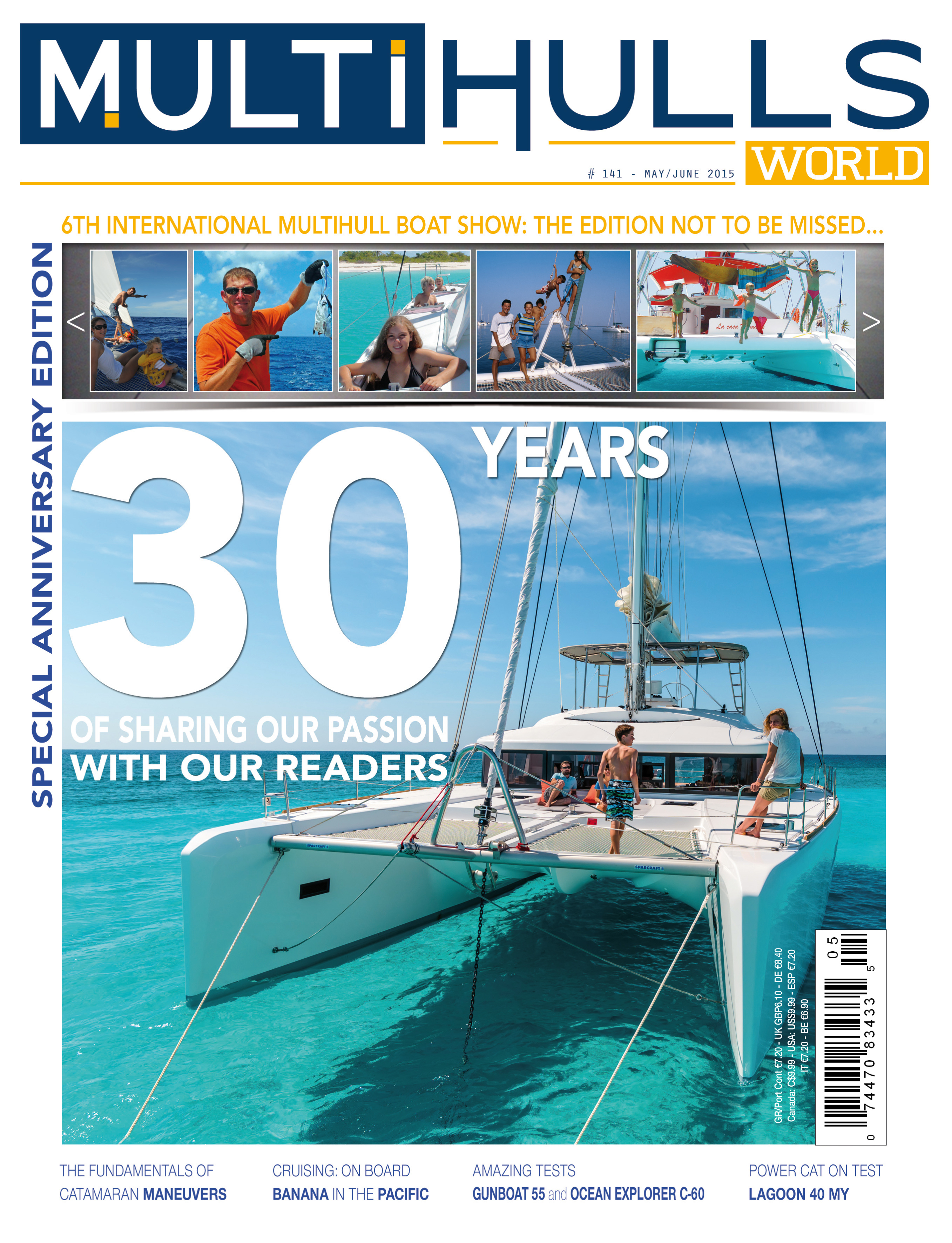
Issue #: 141
Published: May / June 2015
- Price per issue - digital : 5.40€ Digital magazine
- Access to Multihulls World digital archives Digital archives
1) All the Catanas are equipped with daggerboards. They are very long, and held structurally in their cases by the whole height of the hulls. Simple and strong, but beware of the significant windage in the raised position.
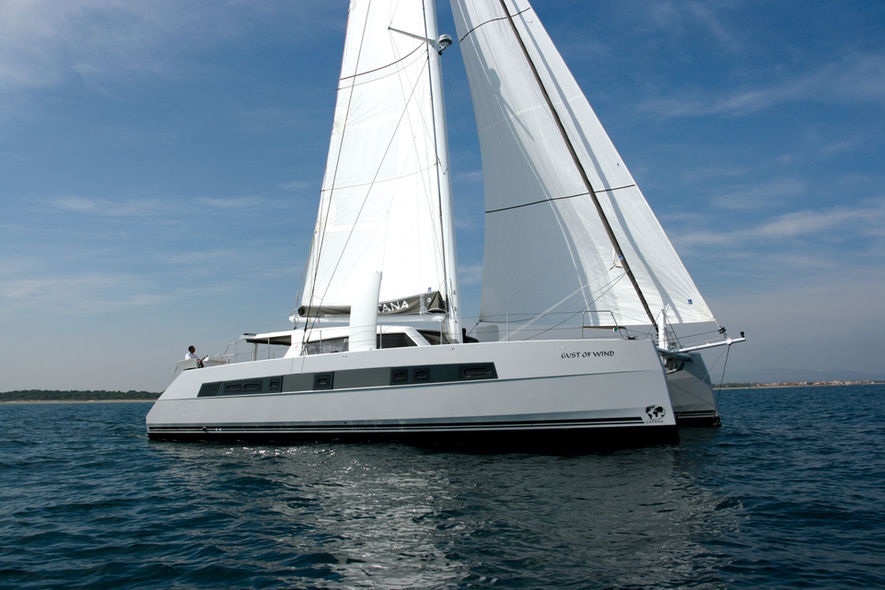
2) The latest Catana models are equipped with curved daggerboards. On the 59, the foil effect is worth 500kg at a speed of 15 knots.
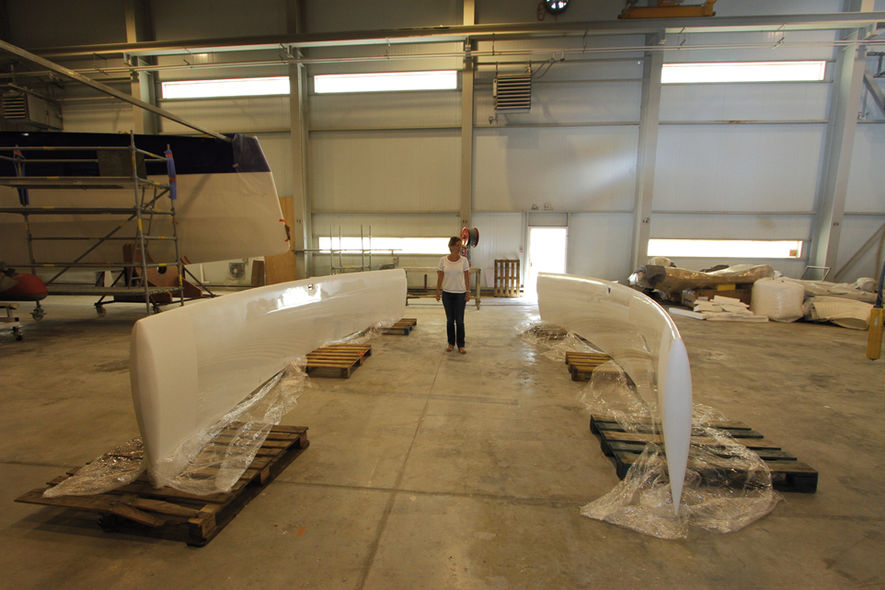
3) The latest Outremers have adopted shorter structural cases, to reduce the size of the daggerboards. Less windage in the raised position and less weight, but the construction is more complex…
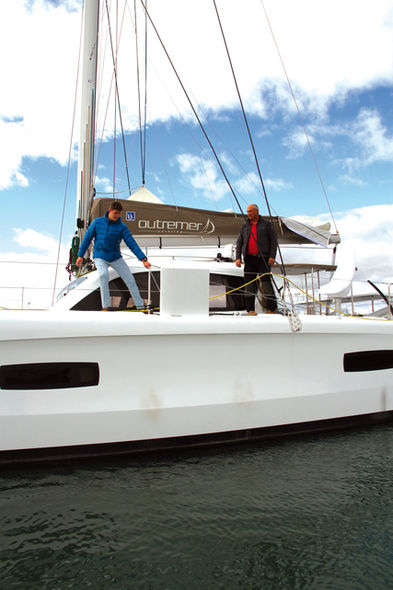
4) Numerous trimarans are also equipped with daggerboards/centerboards. They can be central and integrated into the accommodation, as aboard this Dash 750.
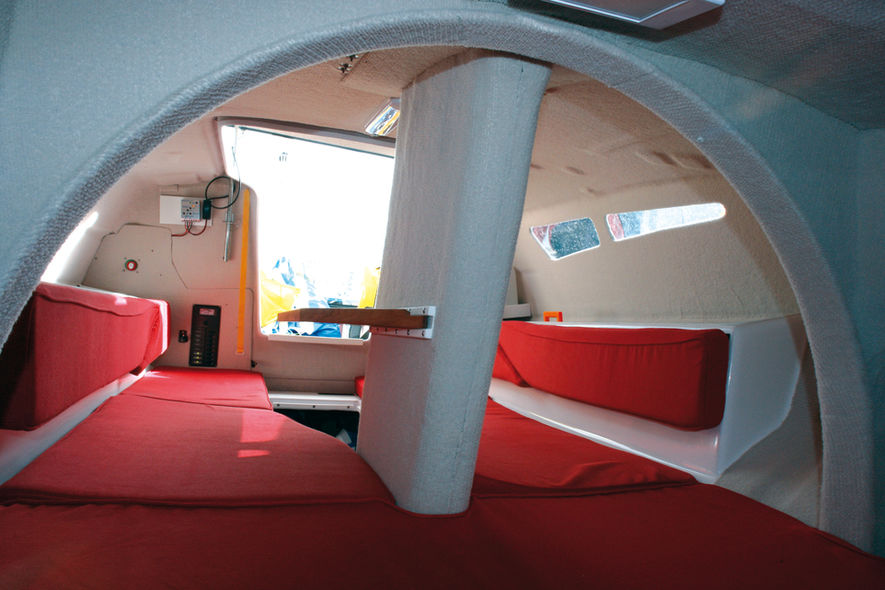
5) Other trimarans, such as the Tricat 25, are equipped with centerboards integrated into the floats.
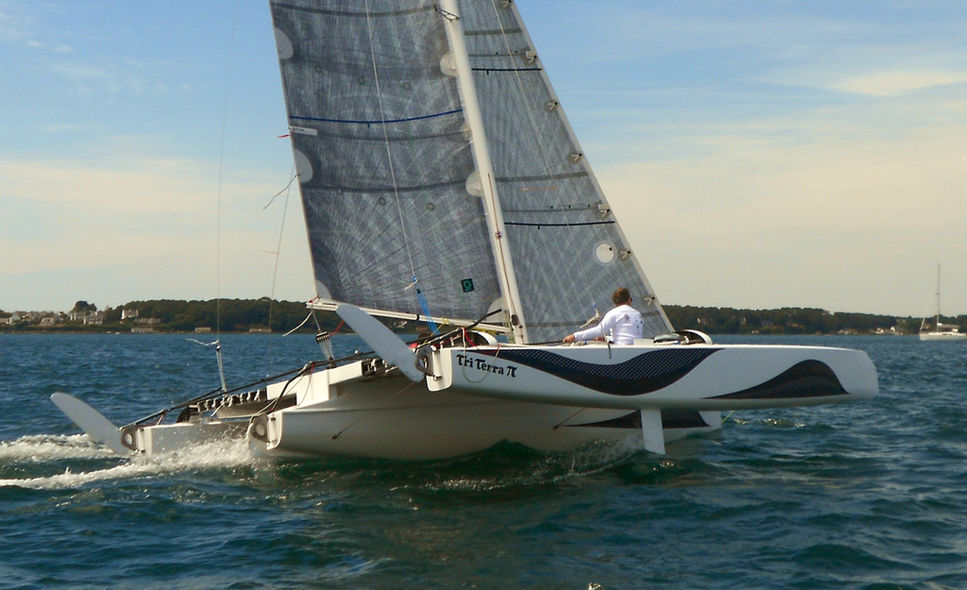
6) Builders such as Outremer provide stopper knots for the daggerboard control lines; a good way to judge the position when the daggerboard is not visible.
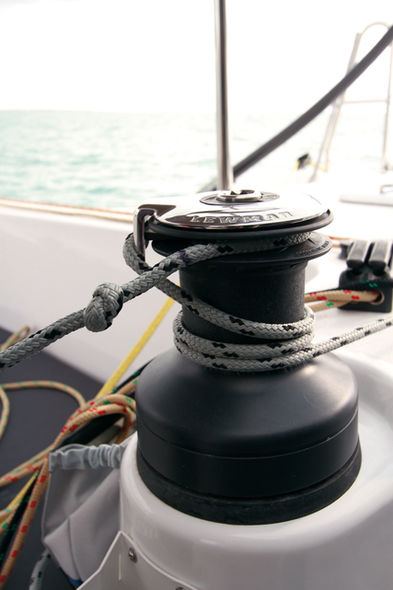
7) Once the daggerboard is out of its case, it is easier to judge: the lifelines are an excellent adjustment indicator!
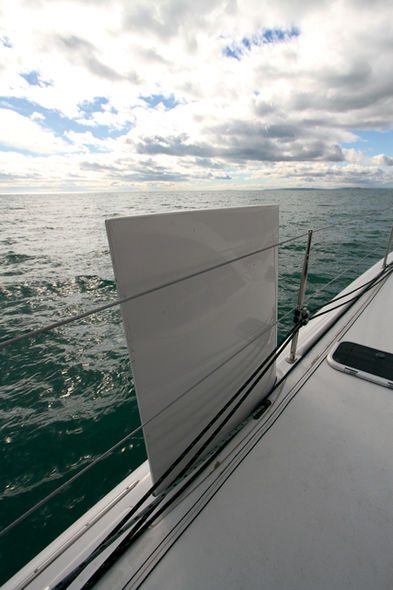
8) To windward in light weather, the daggerboards are fully lowered, to take advantage of maximum 'grip' on the water.
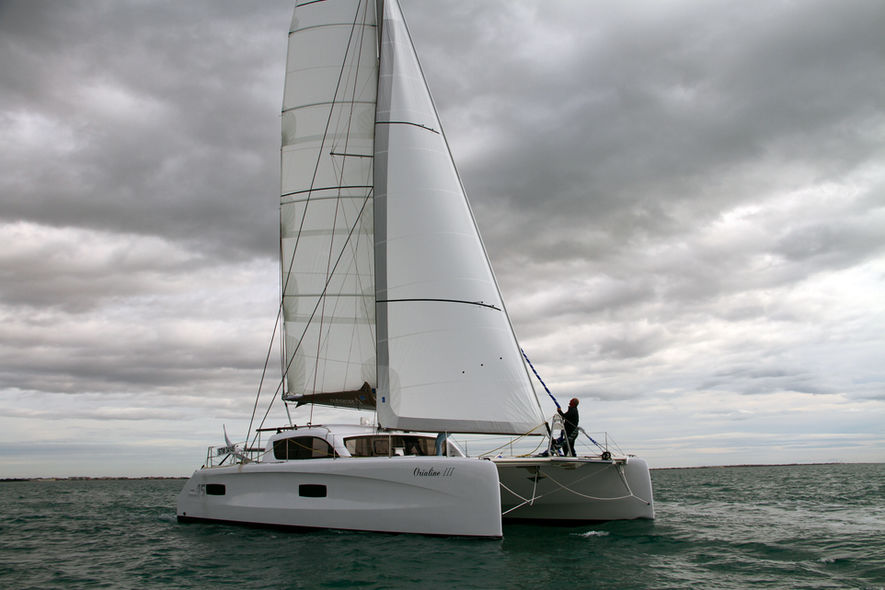
9) When the speed increases, it is worthwhile raising the windward board to optimize drag. Note: a daggerboard which moves is no use. Therefore we raise it!
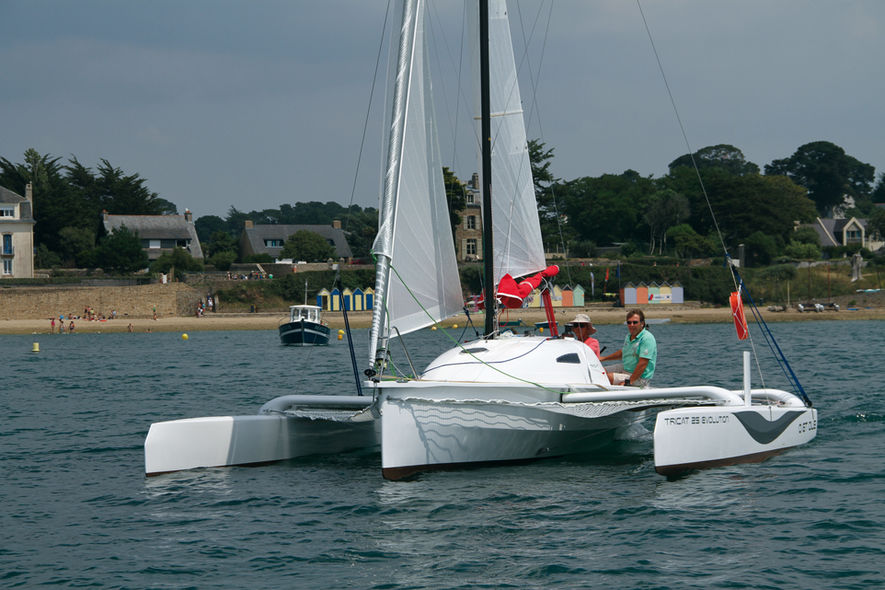
10) But for safety, it is preferable to raise the leeward appendage: in the case of a strong gust, the risk of the boat ‘tripping up’ is thus reduced. The compromise could be to raise both the daggerboards by half... It’s up to you to judge!
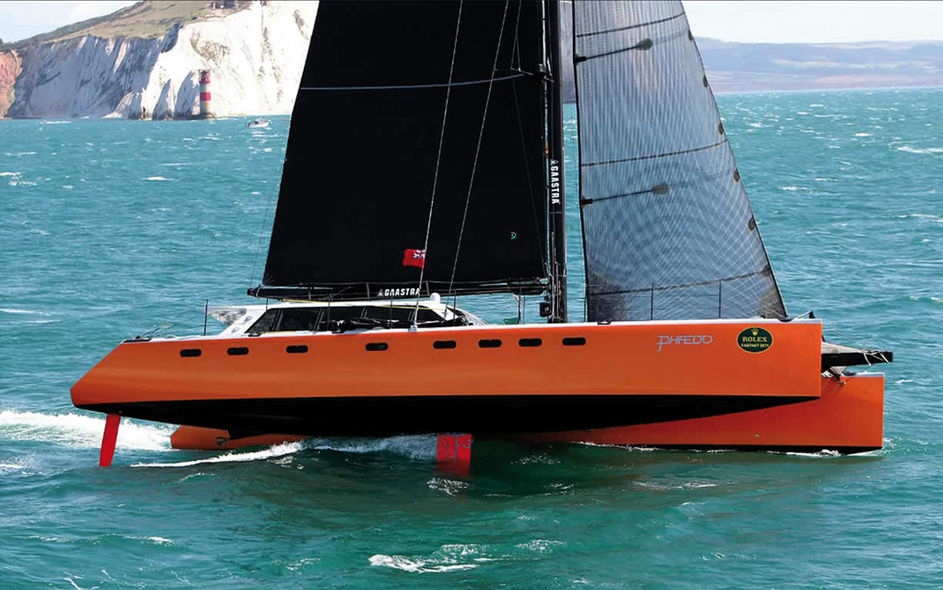
11) Downwind, the daggerboards are no longer useful, especially when the boat exceeds 10 knots... Keeping one third of the surface can however help the helmsman or the autopilot to steer a straighter course.
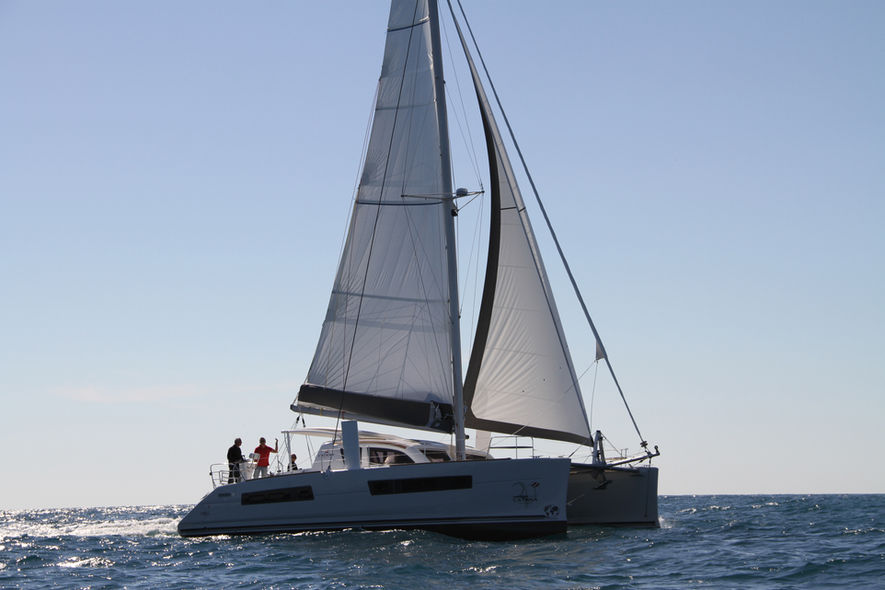
12) Heavy weather? Raise them completely so the hulls slide. On the other hand, with big seas from behind, (just like downwind in more manageable weather) it may be useful to keep a little daggerboard lowered to avoid yawing.
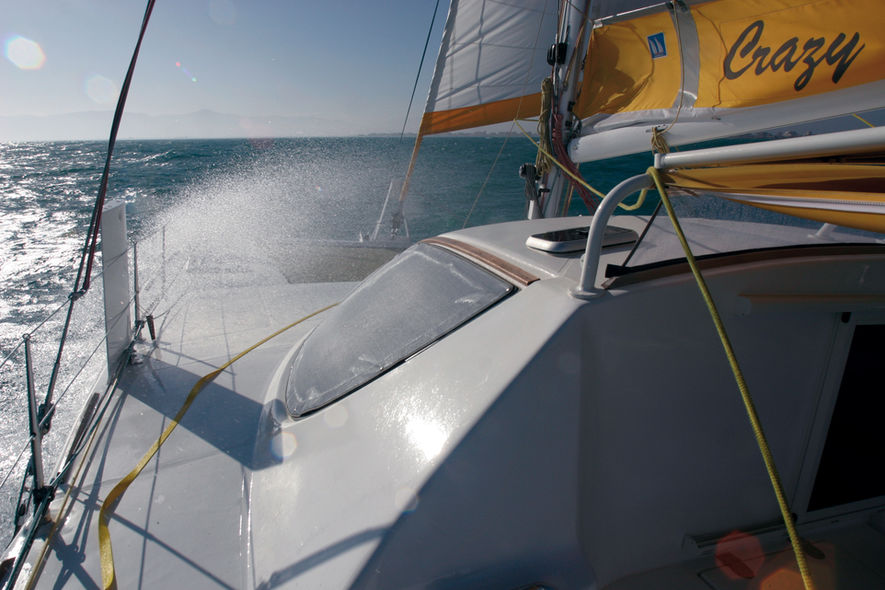
Subscribe to Multihulls World and get exclusive benefits.
Tags :
- préparation ,
- Catamaran basics
Most-read articles in the same category

Drivetrains
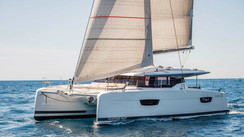
Bending on sails
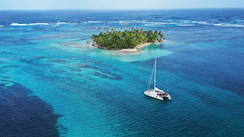
Everything you need to know about trampolines
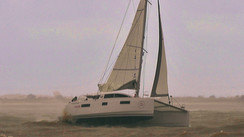
Managing heavy weather in a multihull
What readers think.
Post a comment
No comments to show.
MW #197 - Oct / Nov 2024
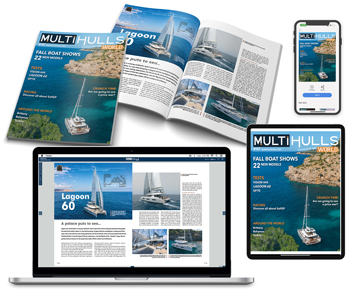
Tenders with two hulls...

Transport under sail

Hydrogen on board
Subscribe now.
The latest news from €3 / month
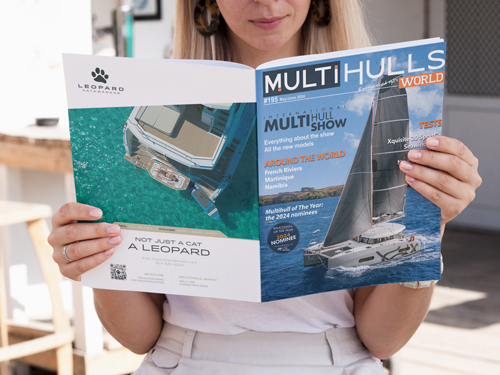
Video of the month
Our latest YouTube hit!

The Multihull of the Year
The 2024 results

Classified ads

Ksenia 149 for sale

Woods Flica 35
Bosgraaf 15m trimaran, minicat 310, vous avez ajouté " " à vos favoris., vous avez supprimé " " de vos favoris., in order to add this article to your favorites, please sign in..

What Are Daggerboards on a Catamaran? (An In-Depth Look)
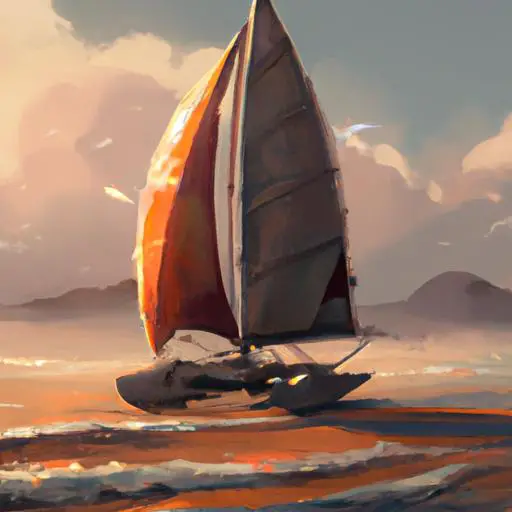
Have you ever wondered how catamarans move so fast and efficiently through the water? The answer lies in daggerboards, a unique and essential feature of these vessels.
Many sailors consider daggerboards to be one of the key advantages of sailing on a catamaran over a monohull sailboat.
If you’re curious to learn more about the science behind this nautical feature, then this article is for you.
Here, we’ll dive into the details of what daggerboards are, how they work, the benefits they offer, the types of daggerboards, and the best practices for maintenance and performance.
By the end, you’ll be an expert on the topic and be able to make an informed decision about the best type of daggerboard for your vessel.
Table of Contents
Short Answer
Daggerboards are vertical boards on a catamaran that can be raised and lowered to provide lateral resistance and stability to the boat.
When the daggerboards are lowered, they provide more stability and can help the catamaran sail closer to the wind.
When they are raised, the catamaran has less resistance and can move faster.
Daggerboards are an important part of a catamaran’s design, as they provide stability and control in difficult weather conditions.
What Are Daggerboards?
Daggerboards are a vertical fin-like structure found on a catamaran, which is a type of sailboat with two hulls of equal size.
Daggerboards are typically located on the centerline of the boat and can be raised and lowered at the skipper’s discretion.
This allows the skipper to adjust the center of effort on the boat, which in turn affects the boat’s maneuverability and control.
At the most basic level, daggerboards provide additional lift and stability to a catamaran, allowing for improved performance in light winds.
They work by creating forward thrust and lift, helping the boat move through the water more efficiently and allowing it to make tighter turns.
Daggerboards also help to reduce leeway, which is the tendency of a boat to drift sideways in the water due to the wind pushing against its sails.
By positioning the daggerboard at an angle, the skipper can reduce the amount of leeway the boat experiences, allowing it to maintain a more consistent course.
Overall, daggerboards are a key component of sailing catamarans and can have a significant impact on the performance of the boat.
With the right setup, they can make a boat faster, more maneuverable, and easier to control in a variety of conditions.
For sailors looking to get the most out of their catamaran, understanding how to use daggerboards is essential.
How Daggerboards Work

Daggerboards, also known as centerboards, are a vertical fin-like structure found on a catamaran.
They are typically located on the centerline of the boat and can be raised and lowered at the skippers discretion.
Daggerboards are designed to provide the catamaran with additional lift and stability in light wind conditions.
This helps to improve the performance of the catamaran by adjusting the center of effort on the boat, allowing for greater maneuverability and control.
When the daggerboards are lowered, they act as an underwater keel, providing additional stability and lift.
This helps the catamaran to cut through the water more efficiently, allowing it to move faster and with greater control.
The daggerboards also help to prevent the boat from drifting sideways in the wind, which can be a common issue with monohulls.
The daggerboards also help to reduce the amount of heeling (leaning) experienced when sailing upwind, making the sailing experience more comfortable and enjoyable.
When the daggerboards are raised, the catamaran will be more maneuverable and have improved performance in light wind conditions.
This is due to the reduced drag caused by the daggerboards not being in the water.
The raised daggerboards will also help to reduce the amount of heeling experienced when sailing downwind, making the sailing experience more comfortable and enjoyable.
The use of daggerboards can significantly improve the performance of a catamaran in light wind conditions and is a key component of sailing catamarans.
By raising and lowering the daggerboards, the skipper can adjust the center of effort on the boat, allowing for greater maneuverability and control.
The Benefits of Daggerboards
Daggerboards are an essential part of sailing catamarans for a number of reasons.
The most obvious benefit of having daggerboards on a catamaran is that they provide additional lift and stability, allowing for improved performance in light winds.
By raising and lowering the daggerboards, the skipper can adjust the center of effort on the boat, giving them greater control over the boat’s maneuverability.
This can be advantageous in tricky situations, such as sailing close-hauled or in tight spaces.
Additionally, daggerboards can help reduce drag in certain conditions.
By raising the daggerboards, the boat can be steered more efficiently by using the hulls to provide lift instead of the daggerboards, which can result in less drag and improved performance.
Finally, daggerboards can help improve the safety of a catamaran.
In rough seas, daggerboards can provide additional stability, helping to keep the boat upright and preventing it from capsizing or being damaged.
This can be especially beneficial when sailing in unfamiliar waters or in bad weather conditions.
In summary, daggerboards are an invaluable component of sailing catamarans.
They provide added lift and stability, can be used to adjust the center of effort on the boat, reduce drag, and improve the safety of the boat.
With all these features, it’s no wonder that daggerboards are a must-have for any serious catamaran sailor.
Types of Daggerboards

When it comes to daggerboards, there are two main types that can be found on a catamaran: retractable and fixed. Retractable daggerboards are typically made of fiberglass and can be raised and lowered at the skipper’s discretion. This allows the skipper to adjust the center of effort of the boat, providing improved maneuverability and control. Fixed daggerboards are usually made of wood or metal and are permanently mounted in the centerline of the boat. These boards provide an extra layer of stability and lift to the catamaran, allowing it to perform better in light winds.
In addition to the two main types of daggerboards, there are also some other variations that can be found on some catamarans.
A daggerboard trunk is a type of daggerboard that is mounted inside the hull of the boat.
This allows the daggerboard to be raised and lowered without having to be removed from the boat.
A foil daggerboard is a type of retractable daggerboard that is designed to provide additional lift and stability to the catamaran, allowing it to perform better in heavier winds.
There are also battened daggerboards, which are a type of fixed daggerboard that is designed to provide additional lift and stability to the catamaran.
No matter which type of daggerboard is chosen, they all provide additional lift and stability to a catamaran, allowing it to perform better in different wind conditions.
By understanding the different types of daggerboards and how they can improve a catamaran’s performance, skippers can make the most of their sailing experience.
Daggerboard Maintenance
Daggerboard maintenance is an important aspect of owning and sailing a catamaran.
It is important to keep the boards in good condition to ensure they are performing as efficiently as possible.
This means periodically checking the boards for wear and tear, making sure they are properly lubricated and free of debris, and ensuring that the fastenings and connections are secure.
Regularly inspecting the boards for signs of corrosion or damage is also important.
If damage is found, it should be addressed immediately to prevent further damage and to ensure that the boards are performing as efficiently as possible.
In addition to inspecting the boards, it is important to keep them lubricated to ensure smooth and efficient performance.
The best way to do this is by regularly applying a lubricant specifically designed for marine use.
This will help reduce friction and keep the boards in good condition for longer.
It is also important to keep the fastenings and connections of the boards secure.
This includes the bolts that attach the boards to the frame, as well as the pins and clips that hold the boards in place.
It is important to inspect these regularly for signs of wear and tear, and to replace them if necessary.
Finally, it is important to keep the boards free of debris or dirt.
This can be done by regularly rinsing the boards off with fresh water after sailing, and by using a soft brush to remove any dirt or debris that has accumulated.
By following these simple maintenance tips, you can ensure that your daggerboards are performing as efficiently as possible and that your catamaran is sailing to its full potential.
Daggerboard Upgrades

The daggerboard is a key feature on catamarans, as it provides lift and stability to the boat.
It is located on the centerline of the boat and can be raised and lowered at the skipper’s discretion.
This allows the skipper to adjust the center of effort on the boat, enabling greater maneuverability and control.
For those looking to maximize the performance of their catamaran, there are several upgrades available for the daggerboard.
A taller daggerboard can be installed to increase the lift and reduce drag, while a lower profile board can provide improved stability.
Additionally, a carbon fiber board can be used to reduce weight, further increasing the overall performance of the boat.
Another upgrade is the addition of a daggerboard trim tab, which allows for more precise control of the daggerboard.
This is especially useful in light winds, as it allows the skipper to adjust the daggerboard to maintain the optimum angle of attack.
This can significantly improve the performance of the boat in light winds.
Finally, there are a variety of shapes available for the daggerboard.
Different shapes are designed to optimize the performance of the boat in different conditions, so it is important to select the shape that best suits your needs.
In conclusion, daggerboards are a key component of sailing catamarans and can have a significant impact on the performance of the boat.
By upgrading the daggerboard, skippers can maximize the performance of their catamaran and improve its overall maneuverability and control.
Daggerboard Performance
When it comes to sailing performance, daggerboards can have a significant impact on a catamaran.
When the daggerboards are up, the center of effort is lowered, allowing the catamaran to sail in light winds with better speed and efficiency.
When the daggerboards are down, they provide additional lift and stability, allowing for improved performance in heavier winds.
The shape and size of the daggerboard also affects the performance of the catamaran.
A wide, shallow daggerboard will provide more lift in light winds, while a narrow, deep daggerboard will provide more stability in heavier winds.
As such, it is important to choose the right daggerboard for your catamaran to get the most out of it.
In addition to improving the performance of the boat, daggerboards can also help reduce drag when sailing upwind.
When sailing upwind, the daggerboards create a venturi effect, which helps reduce the drag on the boat.
This can make a huge difference in performance and can allow the catamaran to reach higher speeds in upwind conditions.
Finally, daggerboards can make a catamaran more responsive to steering.
When sailing downwind, the daggerboards can be used to help the boat turn more quickly and with greater precision.
In this way, the daggerboards can be used to make a catamaran more responsive and agile.
By adjusting the daggerboards, the skipper can adjust the center of effort on the boat, allowing for greater maneuverability and control.
Daggerboards can also help reduce drag when sailing upwind and make the catamaran more responsive to steering.
Final Thoughts
Daggerboards are a key component of sailing catamarans, and their presence has a significant impact on the performance of the boat.
They can provide additional lift and stability, allowing for improved performance in light winds, as well as greater maneuverability and control.
With the variety of daggerboard types, upgrades, and maintenance available, there is something for every boat and sailor.
Understanding how daggerboards work and the impact they can have on sailing performance can help you make the most of your catamaran.
So, take the time to consider the different options and see what daggerboards can do for you.
James Frami
At the age of 15, he and four other friends from his neighborhood constructed their first boat. He has been sailing for almost 30 years and has a wealth of knowledge that he wants to share with others.
Recent Posts
When Was Banana Boat Song Released? (HISTORICAL INSIGHTS)
The "Banana Boat Song" was released in 1956 by Harry Belafonte. This calypso-style song, also known as "Day-O," became a huge hit and remains popular to this day for its catchy tune and upbeat...
How to Make Banana Boat Smoothie King? (DELICIOUS RECIPE REVEALED)
To make a Banana Boat Smoothie King smoothie at home, start by gathering the ingredients: a ripe banana, peanut butter, chocolate protein powder, almond milk, and ice. Blend the banana, a scoop of...
Daggerboard Sailboat: The Ultimate Guide for Smooth Sailing
by Emma Sullivan | Aug 11, 2023 | Sailboat Maintenance

Short answer daggerboard sailboat:
A daggerboard sailboat is a type of sailing vessel equipped with a retractable centerboard, known as a daggerboard, that provides stability and prevents sideways drift. This design allows the boat to navigate shallow waters while still maintaining its speed and maneuverability in various wind conditions.
Navigating the Seas: An Introduction to Daggerboard Sailboats
Ah, the crisp ocean breeze and the rhythmic sound of waves crashing against your sailboat; there’s no doubt that sailing is a thrilling and serene experience. But have you ever wondered how certain sailboats manage to glide effortlessly through the water while others struggle against the wind? The secret lies in their daggerboards.
Daggerboard sailboats, also known as centerboard sailboats, are a fascinating breed of vessels that offer unmatched maneuverability and stability on the open seas. In this blog post, we will take an in-depth look at these remarkable boats, exploring their construction, advantages, and how they enhance your sailing experience .
So what exactly is a daggerboard sailboat? Put simply, it is a type of sailing vessel that incorporates a retractable keel-like appendage called a daggerboard. This vertical fin-like structure is typically made of strong yet lightweight materials such as wood or fiberglass encased in epoxy resin.
The majestic beauty of daggerboards lies in their ability to adjust their depth according to prevailing wind conditions. By lowering or raising the daggerboard through its housing slot in the hull of the boat using an easy-to-operate crank or lever system , sailors can optimize their vessel’s performance for different wind angles and speeds.
Now let’s delve into why these blade-like boards are so crucial when it comes to navigating the seas . Firstly, daggerboards significantly improve a sailboat ‘s lateral resistance. By extending deep into the water when lowered fully, they dramatically decrease sideways drift caused by gusts of crosswind while maintaining stability.
Moreover, these cleverly designed boards enhance upwind performance by reducing leeway – the tendency for a boat to get pushed sideways when sailing against or across prevailing winds. With one or two daggerboards strategically positioned near the centerline of the boat’s hull (depending on its design), sailors can minimize undesirable movement sideward motion and make steady progress towards their destination, even in adverse wind conditions.
Furthermore, daggerboard sailboats can achieve impressive speeds due to their reduced drag. Unlike fixed keel sailboats that have a constant underwater profile, these craft allow sailors to retract the daggerboard fully when sailing downwind or in shallow waters. This feature minimizes resistance and enables the boat to effortlessly surf along the surface, harnessing every possible gust of wind for maximum acceleration.
Aside from improving performance, daggerboards also provide safety benefits. In shallow waters where submerged hazards like rocks or coral reefs are common, being able to raise the daggerboard offers peace of mind by allowing sailors to skim over potential dangers without risking damage to the vessel’s structure.
So there you have it – an introduction to the marvels of daggerboard sailboats. Their innovative design not only enhances maneuverability and stability on the open seas but also unlocks new possibilities for breathtaking speed and safety while sailing. Next time you embark on a nautical adventure, keep an eye out for these remarkable vessels gliding effortlessly through the water – they may just inspire you to explore this fascinating world of sailing further!
How Does a Daggerboard Sailboat Work? Demystifying the Mechanics
Sailing is a fascinating sport that combines both skill and technology. One of the key components of a sailboat is the daggerboard , but for many novice sailors, its mechanics can be quite mystifying. In this blog post, we aim to demystify the inner workings of a daggerboard sailboat and explain how it enables us to harness the power of wind effectively.
To understand how a daggerboard sailboat works, let’s start with a brief introduction to what a daggerboard actually is. A daggerboard is essentially an underwater retractable keel that helps stabilize and maneuver a sailboat . It consists of a long vertical board that is usually made from lightweight yet sturdy materials like fiberglass or carbon fiber.
The primary function of a daggerboard is to prevent lateral movement or drifting caused by wind pushing on the sails . When sailing upwind or at an angle to the wind , the force generated by the sails creates an equal and opposite force known as leeway. Without any form of resistance, this leeway would cause the boat to glide sideways instead of moving forward efficiently .
By lowering the daggerboard into the water, sailors can create resistance against this sideways force. The board acts as an underwater fin, generating lift in much the same way as airplane wings do with airflow over their surface. This lift counteracts leeway and allows the boat to maintain its forward momentum even when sailing close-hauled.
But why use a retractable keel like a daggerboard instead of a fixed one? Well, one advantage lies in adaptability – different boats may require different amounts of resistance depending on factors such as wind conditions or depth beneath them. By adjusting the depth at which the daggerboard extends into water, sailors can fine-tune their craft’s stability and performance .
Another key benefit lies in versatility. Daggerboards enable sailors to navigate shallow waters without running aground by simply pulling up or retracting them fully into their housing within the hull. This flexibility allows sailors to explore more areas and enjoy various sailing conditions with ease.
Now that we understand the basic mechanics of a daggerboard, let’s delve into some clever details about how it operates. One interesting fact is that the daggerboard’s effectiveness is enhanced by combining it with another critical component called a rudder. While the daggerboard provides resistance against leeway, the rudder helps steer the boat in a desired direction .
The interplay between these two elements creates harmony on water. As wind pressure pushes against the sails, generating heeling forces that try to tip the boat over sideways, balancing these forces becomes crucial. To counteract this heeling effect and maintain equilibrium, sailors must strategically adjust both their daggerboard and rudder positions.
In light winds or when sailing downwind, raising or retracting the daggerboard partially can reduce drag and increase speed. Conversely, in stronger winds or when attempting to sail upwind efficiently, lowering the daggerboard completely maximizes resistance against leeway. Balancing this adjustment with precise rudder positioning ensures optimum performance while keeping control of our vessel.
In conclusion, a daggerboard sailboat works by using its underwater retractable keel to create resistance against leeway caused by wind pushing on sails. The lifelike lift generated by the board helps counteract sideways movement and allows for efficient forward sailing even at close angles to the wind . Its usability in various water depths and adaptability make it an indispensable tool for every sailor’s arsenal.
So next time you find yourself marveling at those sleek sailboats effortlessly gliding through water – now you know that it’s all thanks to their ingenious use of a humble yet highly effective mechanism called a daggerboard!
Mastering the Art of Sailing: Step-by-Step Guide for Daggerboard Sailboats
Sailing is an exhilarating and captivating sport that allows individuals to harness the power of the wind and glide through the water with grace. For those who are new to sailing or looking to level up their skills, mastering the art of sailing a daggerboard sailboat can be a thrilling challenge.
Daggerboard sailboats are renowned for their versatility and maneuverability, making them popular choices among sailors of all experience levels. Whether you’re planning to embark on a leisurely day trip or compete in competitive races, understanding how to navigate these vessels effectively is essential .
So, if you’re ready to dive into the world of daggerboard sailboats and unlock your true sailing potential, this step-by-step guide will provide you with the knowledge and expertise needed to embark on this exciting journey.
Step 1: Understanding Daggerboard Sailboats Before setting off on your maiden voyage, it’s crucial to familiarize yourself with the anatomy and fundamental components of a daggerboard sailboat. From the mast and boom that hold up the sails to the rudder that steers your course, every part plays an integral role in successfully navigating through waters.
In particular, grasp how daggerboards work – vertical appendages located beneath each hull that can be raised or lowered according to different wind conditions. These adjustable boards serve two primary purposes: providing stability by countering sideways forces known as leeway and optimizing performance by acting as foils when lowered into the water.
Step 2: Mastering Basic Sailing Techniques Once you’ve acquainted yourself with the boat’s structure, it’s time to hone your fundamental sailing techniques . Start by learning how to hoist and trim your sails efficiently – adjusting both angle (known as “point of sail”) and tension according to wind speed.
Remember that proper weight distribution is vital for maintaining balance while onboard a direct impact on speed control. Whether you’re trimming sails close-hauled or running downwind, understanding weight shift dynamics will greatly influence your boat ‘s stability and maneuverability.
Additionally, practicing tacking (changing direction by turning the bow through the wind) and jibing (turning the stern through the wind) under various wind conditions will improve your sailing finesse. By executing these moves smoothly, you’ll be able to navigate different points of sail with grace and control.
Step 3: Reading and Reacting to Wind Conditions As any seasoned sailor knows, mastering the art of sailing entails becoming attuned to wind patterns and employing them strategically to maximize speed and efficiency. Familiarize yourself with weather forecasts, understanding how unpredictable gusts may impact your vessel’s performance.
By recognizing telltale signs such as ripples on water or changes in vegetation movement along the shorelines, you can identify shifts in wind strength or direction. This valuable knowledge will allow you to adjust your sails, trim them accordingly, and pick an optimal course that capitalizes on favorable winds.
Step 4: Fine-Tuning Sailboat Performance To truly master the art of sailing a daggerboard sailboat, it is crucial to pay attention to every detail that influences its performance. From optimizing weight distribution between crew members to fine-tuning rigging tensions according to wind strength, constant adjustments play a pivotal role in achieving peak efficiency.
Maintaining proper hull balance throughout maneuvers or weight-shifting techniques during heavy gusts are necessary skills that ensure both safety and enhanced performance. Make it a habit to regularly inspect your boat’s rigging for wear and tear – replacing frayed lines or faulty hardware promptly – as even minor issues can compromise its overall integrity while on water.
Step 5: Safety First While conquering the open seas in a daggerboard sailboat promises excitement, it is crucial never to lose sight of safety precautions. Always ensure you have appropriate personal flotation devices for everyone onboard before setting sail .
Prioritize learning essential emergency procedures such as man overboard drills or capsize recovery techniques. Being adequately equipped and knowledgeable about potential risks will provide peace of mind and allow you to navigate challenges confidently.
So, whether you’re harboring a passion for leisurely voyages or aiming to become the next sailing champion, following these step-by-step guidelines will set you on the path to mastering the art of sailing a daggerboard sailboat. Prepare yourself for an adventure that combines skill, finesse, and passionate connection with nature – bon voyage!
Daggerboard Sailboat FAQ: Answers to Your Most Pressing Questions
Welcome to our comprehensive FAQ guide on daggerboard sailboats! Whether you’re a seasoned sailor or just getting started, we have answers to all of your most pressing questions. So, sit back, relax, and prepare to be enlightened!
1. What is a daggerboard sailboat?
A daggerboard sailboat is a type of sailing vessel that features a retractable fin-like board known as a daggerboard. This vertical foil is located in the centerline of the boat and can be raised or lowered as needed. By adjusting the position of the daggerboard, sailors can optimize their boat’s performance in different wind and water conditions.
2. How does a daggerboard work?
When sailing upwind, the daggerboard is typically lowered to maximize lateral resistance and prevent sideways slippage (known as leeway). This allows the sailboat to maintain its course against the wind more efficiently. Conversely, when sailing downwind or in shallow waters, raising the daggerboard reduces drag and prevents grounding.
3. Why choose a daggerboard over other keel configurations?
One advantage of using a daggerboard on a sailboat is its versatility. Unlike fixed keels found on many traditional sailboats, which limit access to shallow areas, a daggerboard can be retracted completely into the hull. This feature makes it easier for sailors to navigate coastal regions with varying depths.
4. Are there any drawbacks to using a daggerboard?
While there are certainly numerous benefits to utilizing this design, there are also some potential drawbacks worth considering. Daggerboards require manual adjustment by crew members during shifts in wind direction or intensity—unlike fixed keels or modern lifting keels that automatically adjust their angle for optimal performance .
5. Which types of boats commonly use daggerboards?
Daggerboards are commonly found in high-performance racing sailboats such as catamarans and trimarans due to their ability to optimize both speed and control through dynamic adjustment capabilities. However, some smaller recreational sailboats, like certain dinghies and beach catamarans, may also utilize this design.
6. How do I properly raise or lower a daggerboard?
Raising or lowering a daggerboard involves using the control lines attached to the board from inside the boat’s cockpit. By adjusting these lines, sailors can safely alter the depth of the daggerboard without needing to leave their position at the helm.
7. Can I replace a daggerboard with a centerboard ?
While they serve similar purposes, there is technically a difference between a daggerboard and a centerboard . A centerboard pivots on a single point and is housed within an enclosed trunk, while a daggerboard slides vertically along guides outside the hull. It’s important to verify compatibility before making any modifications to your sailboat.
So there you have it – an extensive FAQ guide for all your burning questions about daggerboard sailboats! Now that you’re armed with this knowledge, go out there and conquer the seas with confidence!
Choosing the Perfect Daggerboard Sailboat: Factors to Consider
If you are passionate about sailing and desire the freedom of gliding over the open waters, a daggerboard sailboat may be just what you need to embark on your sailing adventures. Renowned for their maneuverability and versatility, these boats offer a thrilling experience for both beginners and experienced sailors alike. However, when it comes to choosing the perfect daggerboard sailboat , there are certain factors that should be taken into consideration. In this blog post, we will explore those essential elements to help you make an informed decision.
1. Stability: One of the most crucial factors in selecting a daggerboard sailboat is its stability. This aspect ensures safety while sailing in challenging conditions or encountering rough waters . For beginners or those seeking a more relaxed sailing experience, opting for a boat with excellent stability will provide peace of mind and make learning the ropes much easier.
2. Performance: Of course, every sailor dreams of experiencing exceptional performance from their sailboat . When considering performance aspects, examining how well the boat handles various wind conditions is vital. A vessel that offers speed and responsiveness under different wind strengths can enhance your overall sailing experience and make it more enjoyable.
3. Size Matters: The size of the daggerboard sailboat plays a significant role in its performance and practicality. If you plan on solo voyages or have limited storage space available, opting for a smaller-sized boat might be ideal as they tend to be easier to handle and transport. On the other hand, larger boats often provide additional comfort features such as ample cabin space with berths where you can relax during extended trips.
4. Construction Material: Another factor that should influence your decision is the construction material used in building the daggerboard sailboat. Common options include fiberglass-reinforced plastic (FRP), aluminum alloy, or even wood-based hulls which each come with their own advantages and considerations regarding maintenance needs, durability, and even resale value. Determining which material suits your needs best will ultimately affect the long-term satisfaction you derive from your sailboat.
5. Budget: Let’s face it – budget plays a significant role in any purchase decision. Daggerboard sailboats can vary greatly in price depending on their features, size, and construction materials. Carefully assessing your budget and keeping it in mind while exploring different options will help you narrow down the choices that align with your financial goals without compromising on quality or performance.
6. Additional Features: Beyond the essentials, remember to evaluate any additional features that may sway your decision-making process. These could include marine electronics, rigging systems, storage compartments, onboard facilities such as toilets or galleys, comfortable seating arrangements, and many more. Prioritize what additional features matter most to you based on your sailing ambitions and preferences.
In conclusion, choosing the perfect daggerboard sailboat involves several considerations including stability, performance under different wind conditions, size suitability for storage and handling requirements/abilities (including single-handed operation), construction material quality/maintenance needs/durability/resale value trade-offs as desired by each sailor’s specific situation), available budgetary constraints – all while factoring in which extra “comfort” features one may prioritize for an optimal overall experience at sea. By carefully navigating through these factors with professional insight and witty discernment tailored to your unique needs, you’ll be sure to find the ideal daggerboard sailboat that perfectly suits both your sailing aspirations and practical demands!
Daggerboard vs Centerboard: Understanding the Differences and Benefits
When it comes to sailboat design , one of the most important considerations is the type of keel or centerboard used. Two options that are commonly seen in sailing vessels are daggerboards and centerboards . While they may seem similar at first glance, there are significant differences between the two that can greatly impact a boat’s performance on the water.
Firstly, let’s start by understanding what these terms actually mean. Both daggerboards and centerboards serve as keels or retractable fins that provide stability and prevent sideways drift when sailing against the wind. They essentially act as underwater foils, countering lateral forces and allowing the boat to maneuver with better control.
Daggerboards, as their name suggests, are long, narrow boards that slide vertically into a slot on the hull of a boat. They often extend deep into the water and provide excellent resistance against sideways movement. This design allows for greater upwind performance since they generate less turbulence compared to other keel types .
On the other hand, centerboards operate differently from daggerboards . Instead of being fixed directly in line with the boat ‘s longitudinally axis like daggerboards, centerboards pivot on a point near their leading edge and can be raised or lowered through an opening in the hull called a trunk. This flexibility enables sailors to adjust their position based on wind conditions and water depth . Furthermore, centerboards have a larger surface area than daggerboards; this gives them additional lift capabilities when partially deployed.
The biggest advantage of using a daggerboard lies in its ability to minimize hydrodynamic drag while sailing upwind. Due to their streamlined shape and reduced wetted area compared to centerboards, boats equipped with daggerboards tend to experience increased speed without sacrificing stability. In racing scenarios where maintaining high speeds is crucial, having a daggerboard could give you an edge over competitors relying solely on centerboard systems.
Conversely, centerboards have their own set of advantages. For sailors venturing into shallow waters or navigating coastal areas with fluctuating water depths, the ability to raise the centerboard is invaluable. By retracting the board partially or fully, boats can avoid grounding and explore even the most restricted sailing spots. Additionally, centerboards offer increased resistance against leeway (sideways drift) compared to fixed keel systems, enabling enhanced control during gusts and maneuverability in tight spaces.
The choice between a daggerboard and a centerboard ultimately boils down to personal preference and intended use. For racing enthusiasts seeking maximum speed and agility on open waters, daggerboards are often the go-to option due to their aerodynamic advantages. However, if you’re more inclined towards versatile cruising experiences that involve both deep sea voyages and coastal explorations, a centerboard would be better suited for your needs.
In summary, while both daggerboards and centerboards serve the same fundamental purpose—providing lateral resistance in sailing vessels—they differ significantly in design and functionality . Understanding these differences will allow you to make an informed decision when selecting the appropriate keel type for your sailboat . So whether you’re aiming for record-breaking speeds or crave versatility in your sailing adventures, choosing the right keel system will undoubtedly enhance your overall experience on the water.
Recent Posts

- Sailboat Gear and Equipment
- Sailboat Lifestyle
- Sailboat Maintenance
- Sailboat Racing
- Sailboat Tips and Tricks
- Sailboat Types
- Sailing Adventures
- Sailing Destinations
- Sailing Safety
- Sailing Techniques
- Outremer 45
- Outremer 4X
- Outremer 4.zero
- Outremer 52
- Outremer 55
- Outremer 51
- Outremer 5X
- All the Outremer Fleet
- Personalized support
- Blue Water Sailing Seminars
- Our concept
- The Outremer team
- Our commitments
- Construction principles
- Our catamaran services
- After-sales customer service & Quality control
- Offshore Connected Catamaran Maintenance
- Concierge Services
- Our owners’ stories
- FAQ – Outremer catamarans

- Brokerage: used catamarans for sale
- Privacy Policy
- Legal Notice
- Grand Large Yatching
Daggerboards: how to adjust them on your catamaran
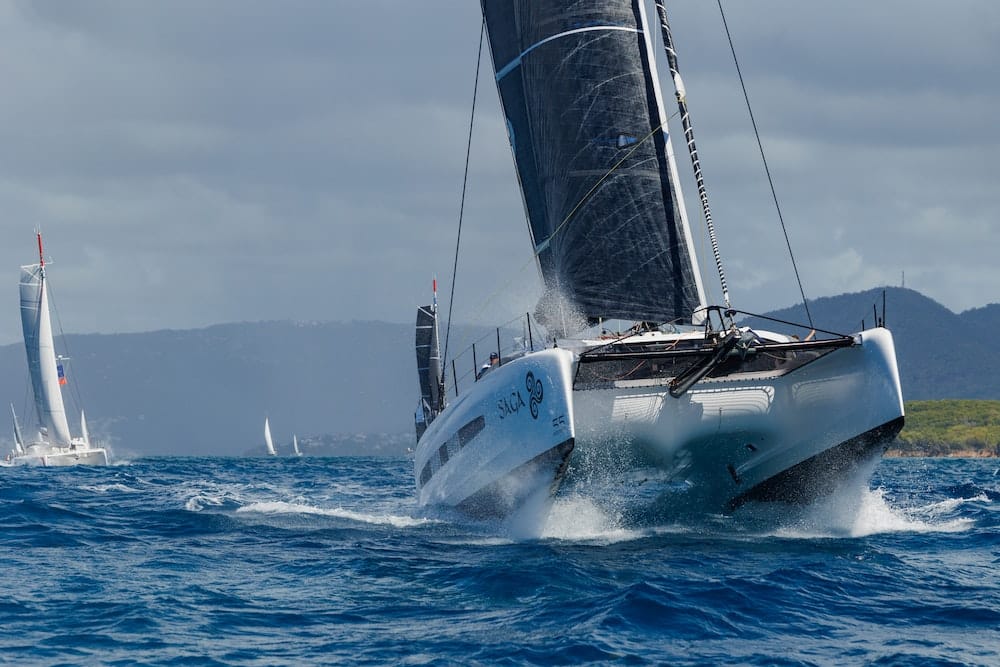
Author : Nikki Henderson
When I asked the Outremer Ladies’ community for suggestions on webinar topics, ‘Daggerboards’ was top of the list. I wasn’t surprised. I don’t think I’ve had a day out on an Outremer with prospective or current owners where daggerboards were not discussed.
It makes sense that there is a curiosity about daggerboards; using them properly is essential if you want your Outremer to perform. What is interesting though, is how confusing people find them.
One thing I’ve realised is that for some people, the issue is similar to my relationship with electronics (hate) and engineering (love). Things I cannot physically see are inherently cloaked in mystery and much more challenging for me to understand. This can be the case with daggerboards: they are hidden underwater and so are often forgotten or misunderstood.
The other reason that daggerboards can be confusing is that they affect not just the performance of a catamaran, but also the safety. Sometimes the theories contradict each other and lead to conflicting advice as to the right and wrong way to use them. In fact, there is no one ‘rule’ about daggerboards. The key, as with anything on a boat, is to understand the reasoning behind the basic daggerboard practices, so that you can make your own decision based on your own unique circumstances that you encounter at any particular time.
I hope this blog will help you build this critical foundation of understanding so that you can set sail safely and with confidence. Daggerboards – like sail trim – is a subject of continual learning. See this as step 1 in the life-long journey.
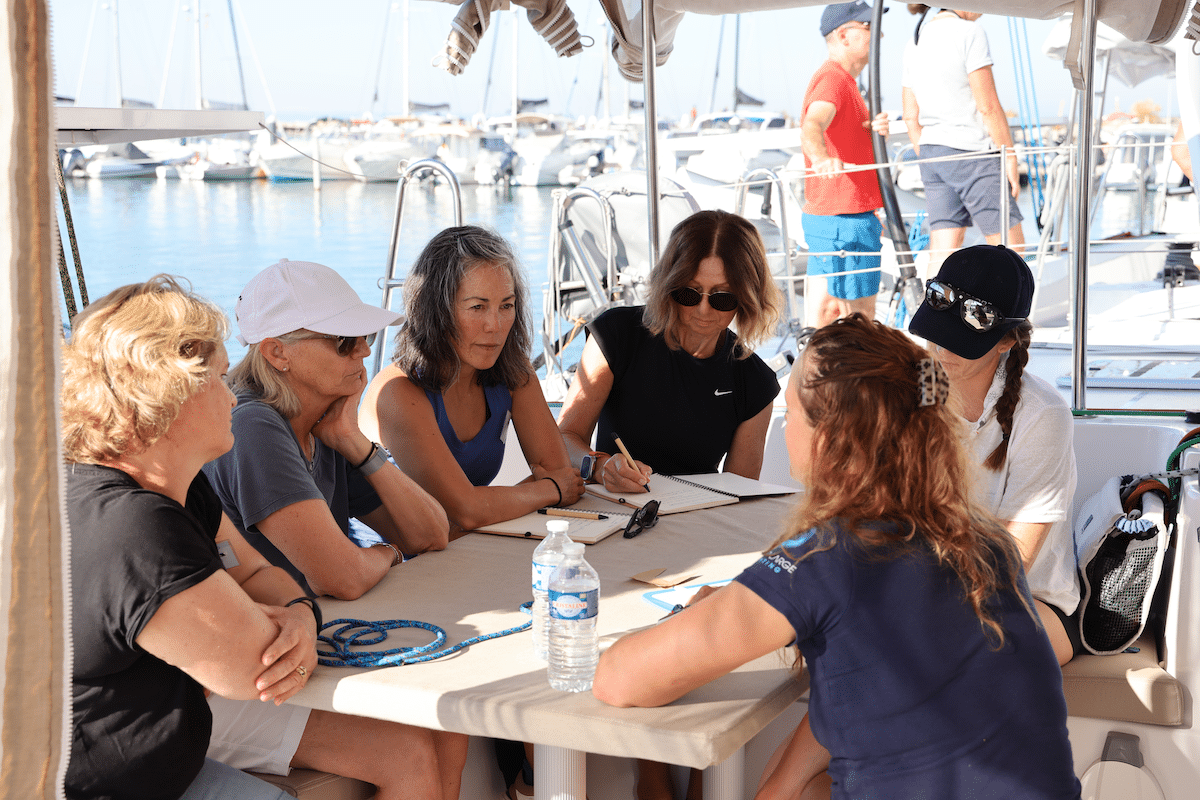
Catamaran daggerboards: how should they be adjusted for optimum sailing?
Daggerboards are best thought of as an ‘underwater sail’ – sometimes called a ‘foil’. Just as a sail above the water needs trimming – so does the sail under the water. But unlike the sail above the water, the daggerboard only has one trim option: how much of it is exposed below the hull.
When sailing upwind the daggerboards provide resistance and lift under the water to balance out the sideways effort force from the sail above the water. In more simple terms, daggerboards help the boat move forward rather than sideways when sailing upwind. Therefore, when sailing upwind, the assumed best practice is to have the daggerboards down. [UP-wind = DOWN-board]
When sailing downwind, the effort force from the sail works almost entirely in the direction you need the boat to go. Therefore, you do not need the resistance under the water from the daggerboard to help with the direction. In fact, it will probably hinder you from sailing deep downwind and slow you down. Therefore, when sailing downwind, the assumed best practice is to have the daggerboards up. [DOWN-wind = UP-board]
Generally, when sailing with wind on the beam – a good ‘go-to’ trim set up is one that is somewhere in the middle of downwind and upwind trim. Therefore, a good starting point for a beam reach would be to lift the daggerboards half-way up.
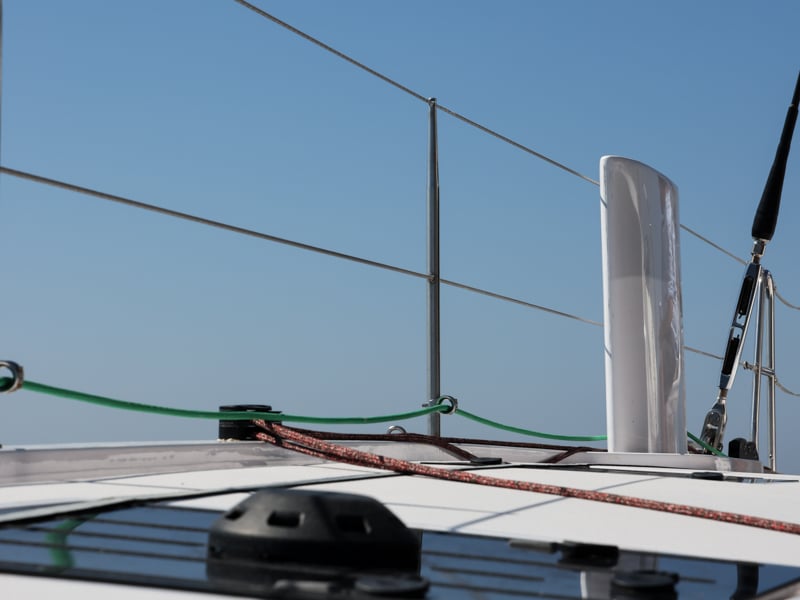
Which catamaran daggerboard for which sailing conditions?
For any competent dinghy sailors who understand daggerboards, this is the most common question as they are typically used to using only one!
An important key principle, is that a daggerboard is only effective when it is submerged in the water. Therefore, if you were sailing the boat purely for performance in a flat sea, you would always need to be trimming at least the leeward one. If the windward hull lifts slightly here and there (which it does fractionally in any substantial wind) then the windward daggerboard is not working efficiently.
Do you drop the windward board? In relation to performance, this depends on how much underwater resistance you need.
In very light winds, the standard practice is to lift the windward daggerboard all the way and only trim the leeward board. When both daggerboards are down, (for simplicity) there is now double the ‘underwater sail’ area. This would likely imbalance how much power there is from the light winds on the sail above the water, and literally ‘drag’ the boat and slow her down.
As the winds increase, there may be a time where you feel you want more underwater resistance, and you could consider lowering the windward board as well. You might find your course over ground improves. Then it was a good decision. If your speed decreases, it might be creating too much drag and you should lift it back up.
If the wind continues to increase further, it is likely you will choose to reef the main. If we return to the concept of the daggerboard being the ‘underwater sail’, if you reef the main, then consider reefing the daggerboard and lifting some up slightly with each reef you put in upwind to keep the boat balanced.
You may be wondering how such a tiny thing as a daggerboard could balance out the enormous sail area of a main sail. The answer here is that water is a much denser fluid than air, and so the daggerboard needs much less area to create the same force than it would do if it were in air.
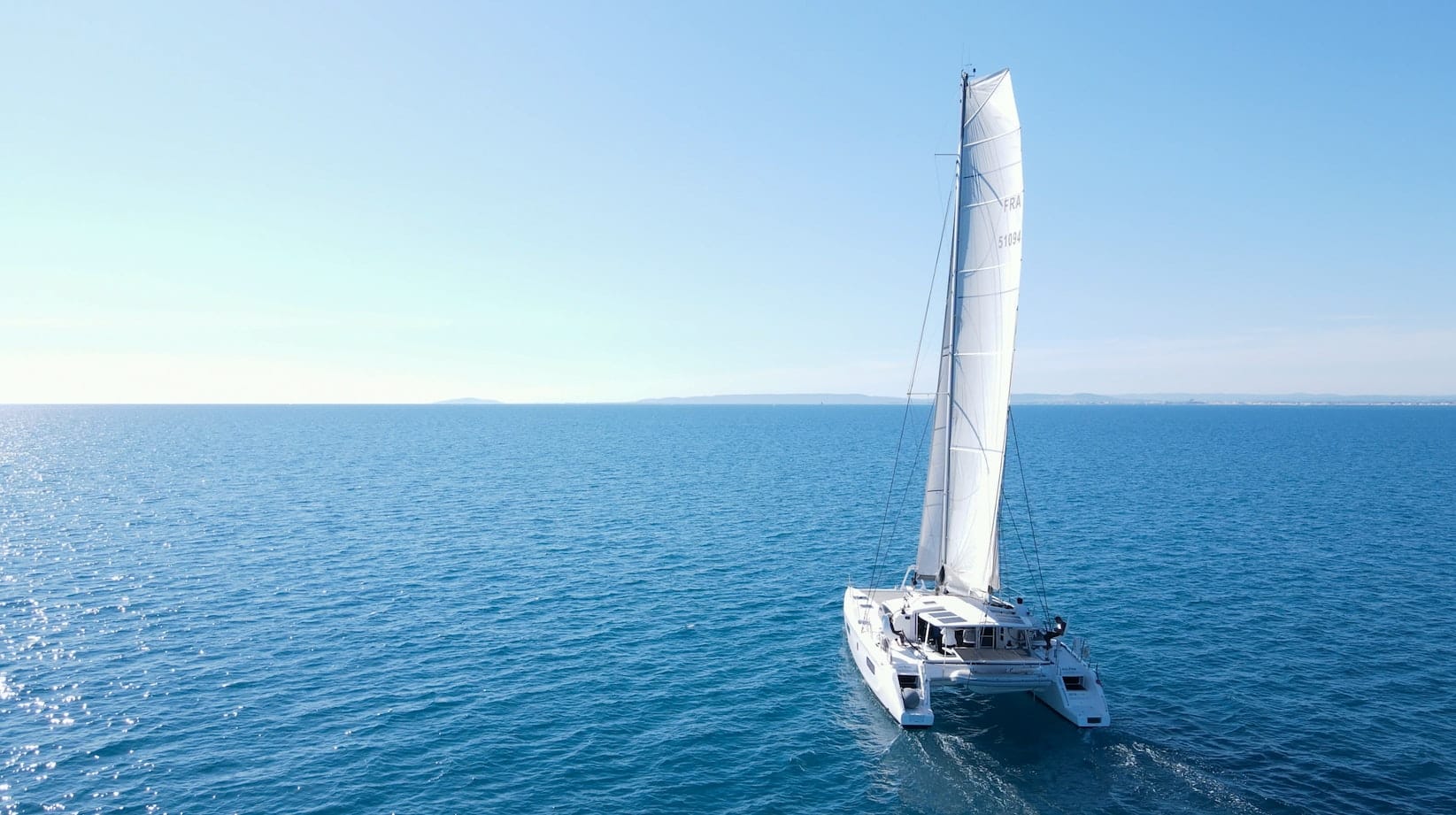
Safety at sea: adjusting daggerboards to avoid risks
This is where things start to get a little confusing.
The leeward daggerboard being down will increase the risk of ‘tripping up’. Therefore, in any significant sea state – or possible impending increase in wind/seastate such as if you are close to a mountainous shore line – where you feel that the hull is, or may, lift a lot, it is in fact safer to lift the leeward daggerboard and only use the windward one. Be aware that you will see a drop in performance as this contradicts the performance best practice of trimming the leeward board and not the windward.
The safest option entirely in very large sea states where the sea is actually tilting the boat significantly from side to side as she rolls down waves is to lift both daggerboards, so you float along waves like a raft.
‘Tripping up’ is a phrase used a lot and in fact sometimes misunderstood. To explain what it means: if there is wind/waves coming from the side of the boat and the windward hull lifts slightly in a wave, or there is a gust and the sail powers the boat forward – the leeward hull can ‘dig in’ to a wave and trip the boat up. The best way to imagine this is imagine getting one of your shoelaces on one of your feet stuck but the rest of your body is still walking. You will fall over. Same with the boat.
A converse argument to lifting the daggerboards up, is that dropping both of them will protect the underside of the boat – from grounding, or from hitting a submerged object. Having both daggerboards partially down can protect the propellor. Having them at ‘deck level’ can protect the rudder. In other words, if you hit something then it will hit the daggerboard before the more fragile underwater equipment.
Another argument against lifting the daggerboards entirely, is that with no daggerboards, your rudder is doing all the ‘resistance-work’. It is hard to believe, but it also acts as a very tiny underwater sail too. There will be a huge load on the rudder with no daggerboard at all and this risk is probably not worth the gain in speed on a long downwind ocean crossing. One way to spot if the rudder is working too hard is just look at your autopilot rudder angle – if it’s maxing out and having to work very hard to keep the boat going straight then you probably have too much sideways slip. It’s a bit like the boat is sailing on an ice rink. In that case, I’d recommend putting both of them down a touch. This will benefit both the ruder and the autopilot (therefore power consumption).
(Read our Safe Sailing article to learn more about safety on board)
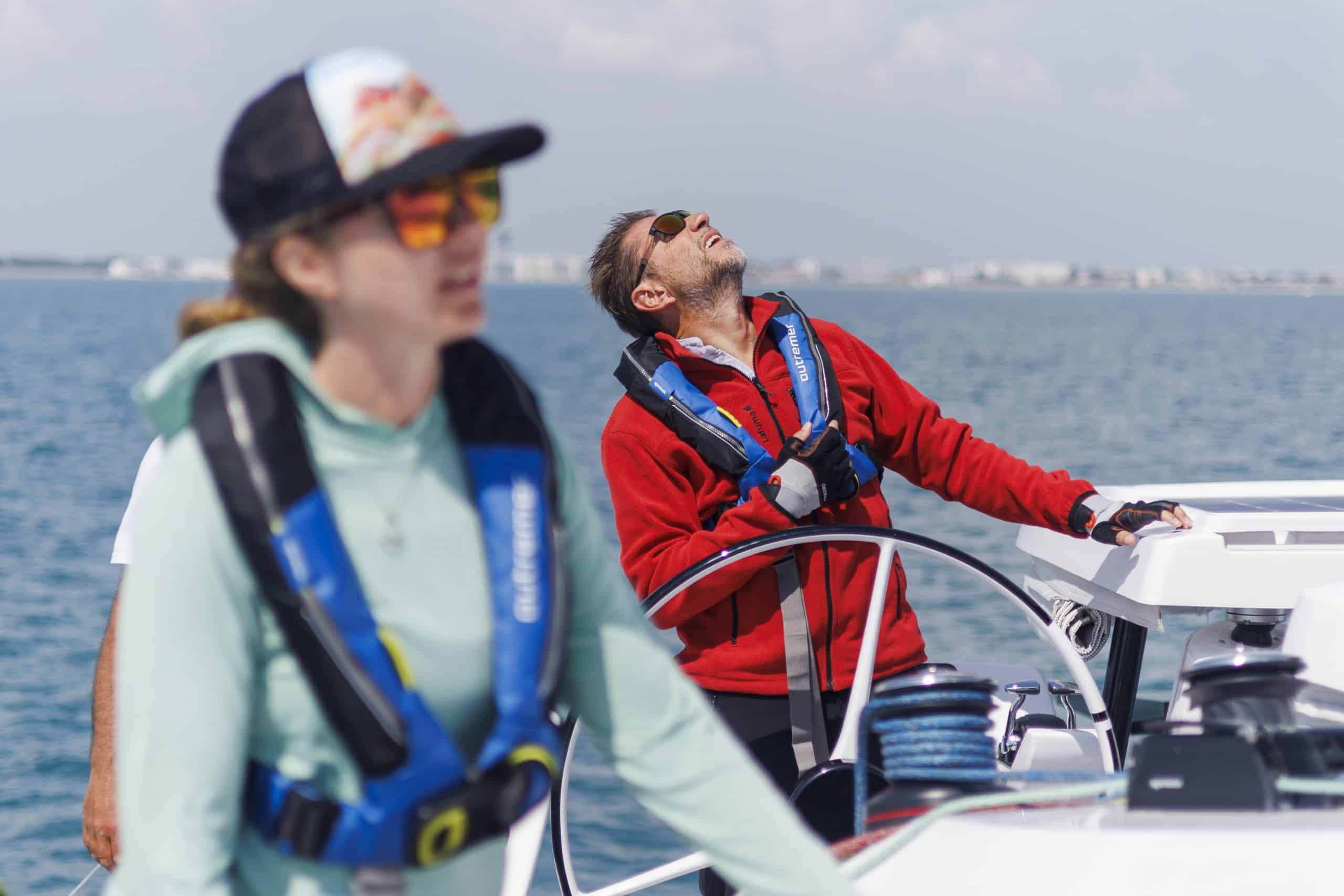
Using daggerboards is a balancing act! Boat weight, weight distribution, sail area, wind strength, sea state, sail trim are all things that effect the decision for how to use the daggerboards: how much daggerboard to use and which one (or both) to use. This is why it’s not an exact ‘one size fits all’ rule and anyone who tells you so is probably oversimplifying it which could lead to a dangerous sitaution. But start using them and see how the boat feels. The beauty of buying an Outremer is that if you keep her lightweight and trimmed well, then she will talk to you and tell you what feels good. Don’t believe me? Try sailing a brand-new Outremer out of the factory before she has anything on – then compare it to one with four peoples’ life belongings on – and you will see what I mean. 😉
Continue navigation
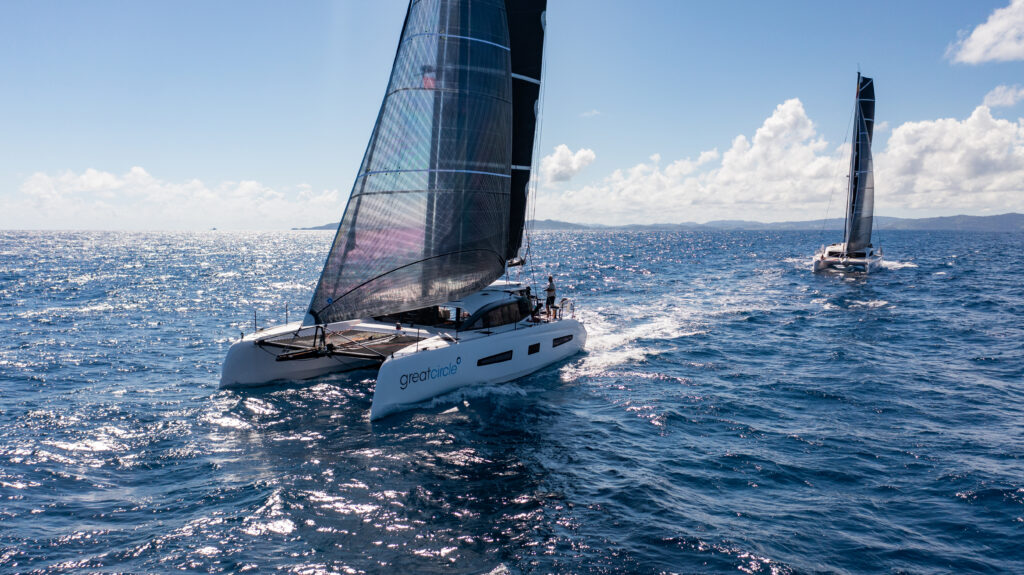
40.000 miles and 3 years to get from La Grande Motte to La Grande Motte
Marijke and Mark sail the Outremer 55 Great Circle.
Since its launch in 2021, the boat has sailed around the world with the GLYWO 500.
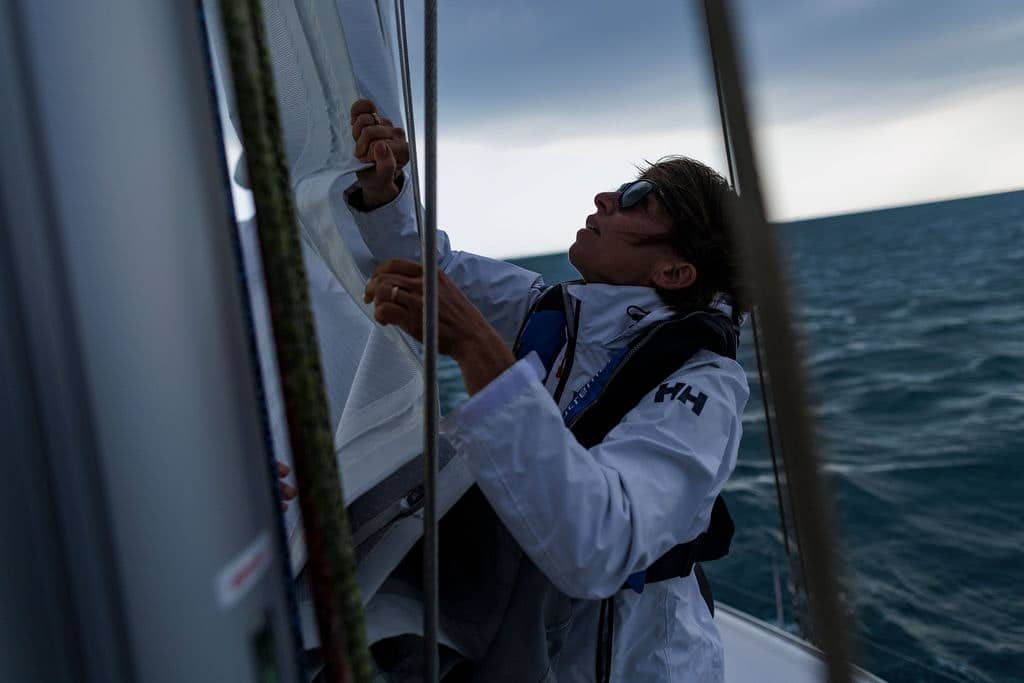
Setting off on a catamaran with the best sailing weather
When you’re getting ready to set off on a sailing trip, it’s vital to find out about the seasons and weather phenomena in your chosen sailing area. Even before choosing your cruising destination or travel itinerary, or even selecting your yacht!
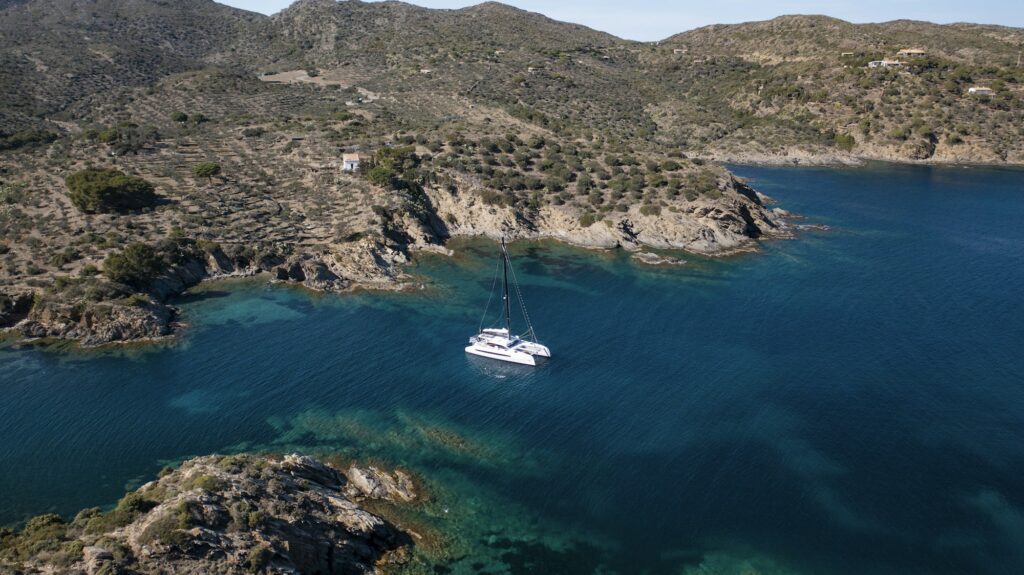
Catamaran VS Monohull: what should you choose to sail around the world?
Sailing around the world is a dream come true: you discover the world to the rhythm of the wind and the stopovers, exploring new destinations every day as you sail. If you’re just starting to read this article, you’re probably nurturing this project. Are you planning to sail around the globe? Then the choice of ship for your next voyage is crucial.

9 Best Cruising Catamarans With Daggerboards or Centerboards!
As an Amazon Associate, we earn from qualifying purchases. We may also earn commissions if you purchase products from other retailers after clicking on a link from our site.
Many sailing enthusiasts shopping for their first cruising catamaran might find it rather challenging to determine the best choice for their needs. If you’re in the market for a cruising catamaran with a daggerboard, then look no further. I have done the research and built a list of nine of the best daggerboard catamarans.
The best cruising catamarans with daggerboards or centerboards provide great cruising capability, comfortable living, ease of handling, and strong construction. Based on different styles, designs, sizes, and prices, some of the best catamarans are Outremer 45, Catana 50, and Balance 526.
If catamaran cruising is a passion you have been longing to pursue, keep reading. You might find your dream boat and become inspired to make your cruising vacation a reality.
Dagger/Centerboards and Their Role in Catamaran Sailing
Unlike a traditional sailboat with a single hull (monohull), a catamaran balances on two hulls, with the sails sitting in the middle. Some catamarans come equipped with daggerboards (or centerboards) whose work is to balance the force of the wind acting on the sails.
Understanding the difference between centerboards and daggerboards can help you make an informed decision when selecting a sailboat or when considering modifications to your current vessel.
If you’re sailing a catamaran with daggerboards, you’d raise the daggerboard on the leeward hull while fully extending the upwind daggerboard. This improves the catamaran’s stability when sailing windward during heavy conditions. The adjustment thus makes the boat less susceptible to capsizing.
When will a catamaran capsize?
Should You Choose a Catamaran With Daggerboards?
In general, catamarans with daggerboards perform far, much better than those without. That’s because the boat’s design focuses heavily on performance. What’s more, renowned experts design the boats with the best hulls and make the boats lighter by tweaking the materials used.
In general, catamarans with daggerboards perform far, much better than those without.
So, if you’re looking to reach speeds of 28 all the way up to 30 knots (55 km/h), then choose a cruising catamaran equipped with daggerboards. When sailing upwind, such catamarans sail much closer to the wind and are way faster than their comfort-focused counterparts. In comparison, most traditional cruising boats can only manage 10-15 knots (18-27 km/h).
What makes the catamaran so fast, and why is this type of boat even faster?
- You can cover much longer distances in a day with a daggerboard catamaran.
- Their high speed allows for faster ocean crossings.
- They deliver superior performance, particularly in upwind directions.
- You can anchor your catamaran on shallow waters – after raising the boards.
- A faster cruiser means additional safety since you can outrun a storm or avoid an incoming one.
- They entail more work and maintenance.
- They require you to learn how to operate them safely.
- They are expensive – daggerboards come with an additional amount of up to $30.000 on the construction price.
- The daggerboard compartment consumes some of the space from the hull’s living area, thus limiting your comfort.
Now, let’s have a look at some of the best cruising catamarans with daggerboards.
The Dolphin Ocema 42
The Dolphin Ocema 42 is a cruising catamaran built in Northern Brazil. The boat comes equipped with daggerboards and can thus point higher windward. But it also boasts a smaller wet surface when running and can pull with ease into shallower anchorages – 3 feet ( 0.91m) or less. That means that you can anchor your catamaran far from the crowd (or beach it ), then walk ashore. It also gives you more anchorage space to choose from.
However, it’s important to note that:
- Raising the Dolphin’s daggerboards means exposing her rudders from underwater hazards.
- The daggerboard could place the hull’s integrity at risk in case of a grounding.
- The trunk consumes valuable interior space.
Created by designer Philipe Pouvreau, the Dolphin 42 is the only Dolphin model that boasts daggerboards. The boat strives hard to balance performance and comfortable cruising in a compact package. As a result, the cruising catamaran sports a foam core which helps in reducing its overall weight.
While some of the Dolphins built later at various custom shipyards bear some additions or structural modifications, most Dolphins are high-quality, safe, comfortable, and perform successful circumnavigations.
Pricing : $220,000-$350,000
The Outremer 45
The Outremer 45 is a Gerard Danson design. This classic cruising catamaran is unique in that it didn’t undergo mass production like most multihulls. Instead, the French Outremer came from a semi-production manufacturing line where all interior parts are laminated directly to the hull, forming an extremely stiff structure.
This classic cruising catamaran is unique in that it didn’t undergo mass production like most multihulls.
One downside to this catamaran is that it comes with a much smaller interior than other boats. Also, it doesn’t come cheap. However, everything else about the Outremer makes it the perfect sailor’s boat because:
- It’s highly responsive to the helm.
- It has a high bridge deck clearance.
- It comes with well-proportioned bows.
- It features balanced weight distribution, which helps to minimize pitching.
Earlier models featured soft canvas bimini (optional) covering a stainless framework, while later ones had optional overhead composite panels. The latter provides a better option since canvas tends to become waterlogged when it rains.
You can order the Outremer 45 as an owner version, a club version with additional berths, or a four-cabin layout.
Pricing: $320,000-$560,000
The Atlantic 42
The Atlantic 42’s efficiency and aesthetics have resulted in the growth of a massive loyal following. Despite being the smallest of the Atlantic cruising catamarans, the A42 is quite popular with sailors due to its ocean-faring capabilities, ease of handling, and excellent use of space. This catamaran embodies a true classic right from the forward cockpit, through the pilothouse, the sleeping cabins, to the galleys.
Unlike other catamarans, the Atlantic 42 has a waist-high cockpit located in front of the pilothouse and behind the mast. It boasts a solid construction owing to the large metal bearers running over the bulkheads.
Unlike other catamarans, the Atlantic 42 has a waist-high cockpit located in front of the pilothouse and behind the mast.
This setup provides the boat with maximum strength, better air circulation beneath the engine, and high flexibility when it comes to engine size and positioning.
At first, the vessel’s style and outlook appeared rather conservative, but with time, it was evident that the Atlantic 42 was a long-lasting catamaran built using high-quality materials. The boat’s exterior looks stunning, and the interior is quite impressive as well, while spacious aft cabin accommodation and shower compartments are an additional bonus.
Pricing: Contact Chris White Designs
The Gunboat 62
If you’re looking for a vessel that can fit all your gear plus more during your voyages, then the Gunboat 62 is the ideal cruising catamaran for you. And guess what? You can stuff all your gear and equipment in this vessel and still outperform a similar-sized racing monohull. The boat’s helm seat is not only comfortable but also offers 360-degree visibility, ample storage space, a working surface, and a luxurious cabin.
The Gunboat 62 is among the best top-performing catamarans in the market, and this particular series set up the Gunboat brand. It performs incredibly well during storms with speeds of 35 knots (64.82 km/hr) and beyond despite its epoxy, E-glass, and carbon-fiber build. Furthermore, its design features a distinct angular outline, quite unlike most similar-sized catamarans.
The Gunboat 62 is among the best top-performing catamarans in the market, and this particular series set up the Gunboat brand
Since it’s light in weight, this catamaran can sail upwind at speeds above 17 knots (31.48 km/h) while pinching up to 30 degrees. Indeed, this catamaran boat can easily tack through 95 degrees and still manage to outshine the fastest racing monohull. And, like most performance catamaran cruisers, the Gunboat 62 can reach almost 20 knots (37.004 km/h) under the right conditions.
Pricing: Contact Gunboat
Check out this list of the fastest cruising Cats on the market!
Gemini 105Mc
The Gemini 105Mc is the ideal cruising catamaran for you if you’re in the market for a boat to use for weekend sailing trips. The boat is also comfortable enough for long cruising vacations since it boasts spacious accommodation, great design, and delivers a stable cruising platform.
This vessel is more of a sailing cottage. Designed by the renowned Tony Smith, the 35 feet (10.6m) floating cottage is also cozy, safe, and good value for money since its price is quite reasonable.
This vessel is more of a sailing cottage.
The boat comes with incredibly slim, teardrop-shaped hulls with flat bottoms and a smaller wetted surface, allowing for minimal drag. It also leads towards more leeway when under sail. The hulls sport a kick-up centerboard which helps to enhance the catamaran’s windward pointing abilities. Furthermore, the rudders rise to enable the boat to cruise in shallow waters with ease, while most vessels tend to run aground.
The Gemini 105Mc has a narrow beam measuring about 40% of its length. This is quite unlike today’s beams at 50%. Still, the boat’s low center keeps it upright, stable, and safe. Although no longer in production, you can still purchase a preowned Gemini 105Mc .
Pricing: Contact Gemini Catamarans
The Catana 50
There are only 2 Catana production sites in France, this guarantees exceptionally high-quality standards in every boat. The Catana infrastructure is more advanced than that of other catamarans and features spacious bridge-deck clearance and a high freeboard. In addition, its curved daggerboards drastically reduce the drag, while crash boards ensure the buoyancy of any of the Cantana models.
The Catana 50’s daggerboards angle slightly inward to maximize lift under sail and enhance lateral resistance underwater. They are thus more effective than the long but shallow keels found in other catamarans. As a result, this catamaran performs exceptionally well to windward. When sailing off the wind, raising the boards helps to minimize drag.
The Catana 50 is an ultramodern catamaran designed to make long-distance passages easy and safe. This massive sailboat measures almost 50 feet (15.24m) long and sports a beam of around 26 feet (7.92 m). Most people consider it the best-built and most fashionable cruising catamaran, but the boat is bound to test your sailing skills if you plan to sail it solo.
The Catana 50 is an ultramodern catamaran designed to make long-distance passages easy and safe.
The amazing catamaran features a rig that allows you to use a screecher or a self-tending jib. While this might sound complex, the Catana 50 is fairly easy to tack once you set out on the course.
This performance-oriented catamaran boasts efficient hulls and rigs that allow for fast speeds. Also, its long waterline, along with the bow’s subtle underwater shape, helps boost volume while lessening wave drag. The stern platforms can also aid in stretching the length of the waterline while allowing easy access from a dock. If a collision were to occur, the sturdy board trunks would protect the hulls.
Pricing: About $1.4 million
McConaghy MC50
The McConaghy MC50 launched in 2018. A fast cruising cat designed to cross oceans, this catamaran came with impressive features such as a skylight smack in the center of the coachroof that allows light to flood in. Also, the saloon has an extending table that provides adequate space for up to eight diners and converts into a lounging room when you install the fill-in cushion.
The galley boasts an induction hob and molded-in sinks, while a navigation station occupies a spot at the front of the saloon – providing good visibility and systems access. The vessel’s unique design simulates a penthouse apartment on the deck with 35 to 40m2 (376.74 to 430.56ft2) of space, possibly the largest in a 50ft (15.24m) yacht.
The MC50’s 3.5m-deep (11.48ft) hydraulic centerboards boost the boat’s upwind performance and include a fail-safe if an underwater collision occurs. The boards take only 12 seconds to raise. This catamaran delivers great pace and upwind capability, all wrapped up in a high-quality, stylish, and roomy interior.
The key to the MC50’s outstanding performance is the optimized hull shape and the 40% carbon fiber lay-up, which result in greater stiffness. Exhibiting great engineering detail, the hydraulic centreboards swing into the hulls, providing a welcome solution to the challenge of having daggerboards without eating up too much accommodation space.
Pricing: Contact McConaghy Boats .
Atlantic 47 Mastfoil
The Atlantic 47 is one of Chris White’s spectacular designs. It places the cockpit forward of the deckhouse, the aft deck sits behind the pilothouse, and the large pilothouse has easy hull access.
This unique design enhances the safety and functionality of the Atlantic 47 as it provides the crew with full forward visibility and easy, safe access to the sailing controls. It also transforms the traditional deckhouse into an appealing and more comfortable pilothouse.
All Atlantic cats come equipped with daggerboards, with the majority sporting vertically retracting ones. That’s because to sail upwind really well, a catamaran requires deep, well-shaped hydrofoils underneath the boat to enable it to claw windward.
An excellent top performer, the Atlantic 47 combines great cruising capability, comfortable living, and ease of handling. This spacious boat also boasts a generous aft deck, a high all-around bulwark, and a starboard walk-through for quick and easy access to the dinghy.
All Atlantic Cats sport an impressive safety record owing to their robust construction, innovative design, and easy handling. Besides, the indoor watch-keeping capability helps to minimize crew fatigue, allowing safe and more enjoyable cruising. To further enhance their safety, all boats contain watertight collision bulkheads in addition to emergency capsize habitation.
Pricing : Contact Chris White Designs .
The Balance 526
A passion for building the best-performing cruising catamaran d esigned for speed, comfort, and perfect for families . The ability to carry cruising payloads inspired the Balance 526 . Designed by a team highly experienced in sailing, cruising, racing, and building catamarans, the 526 is simple to operate, maintain, and offers gracious, elegant living.
With state-of-the-art beds, showers, cabinetry, and finishes, the European-styled interiors feature high-end interior design. What’s more, you can pilot this exceptional vessel single-handed owing to the innovative design, reefing station, and self-tending blade jib . These features allow almost anyone to maneuver the catamaran safely through any weather.
If you’re seeking optimal performance under sail, you can configure this cruising catamaran with either dual daggerboards or high-performance fixed keels . The great thing about using the fully retractable dual daggerboards is that you can sail in shallow waters and beach your catamaran without any problems.
To enhance upwind performance, place the boards in the down position, and raise them to improve off wind performance. In dangerous cross seas, the Balance 526 side-slips prevent the tripping effect related to large fin-keeled catamarans.
The balance 526 comes with the all-weather Versahelm design. A first in catamaran design, it accords serious cruisers the best of both worlds. You can slide open the hardtop and sail in the open air during fair weather, close it in foul weather, and get into the aft cockpit. The down position allows you to scan around as you look for docking and provides a warm, safe, and comfy place to pilot the 526 in any weather.
To combat fatigue, the Balance 526 thoughtfully comes with adjustable helm chairs. There’s also a retractable helm standing platform that you can raise to increase sightlines whenever you pilot over the bows, navigate narrow channels, or cluttered estuaries.
Strong but light, this vessel weighs under 12.5 tons (11,339.81 kg). Hence, if you ever need to outrun or position away from bad weather, the Balance 526 will speedily and safely take you wherever you need to go.
Pricing : Contact Balance Catamarans
Final Thoughts
As you can see from this list, cruising catamarans with daggerboards are available in a wide range of designs, styles, and sizes. This can make choosing the best one a bit overwhelming. Still, whether you’re looking to get a catamaran at a bargain, an exceptional performer, or a classic, there’s a boat to suit every need and budget.
The best thing is to look beyond the fancy designs, layout, or equipment and consider fundamentals. These include sound construction, a good sail plan, cruising capability, ease of handling, and comfortable living.
- Wikipedia: Daggerboard
- McConaghy Boats: McConaghy Boats
- Sail magazine: 10 Great Cruising Cats
- Sail magazine: Catana 50
- Gunboat: Home
- Gemini Catamarans: Home
- Gemini Catamarans: Gemini 105Mc Design Touch Overview
- Chris White Designs: Atlantic 47 Mastfoil
- Chris White Designs: Home
- Catamaran-Outremer: Outremer 45
- Sail How: Which Catamarans Have Daggerboards?
- Yachting World: Performance cruisers: the best new catamarans for racing and fast cruising 2018
- Dreamy Yacht Sales: Best Catamaran Brands Guide – 6 Top Catamarans
- Hellenic Shipping News: Daggerbards in Demand on Cruising Boats
- Balance Catamarans: The Perfect Harmony of Performance and Livability
- Multihulls-World: Catamaran Basics the Daggerboards: Understanding and Adjusting Them
Owner of CatamaranFreedom.com. A minimalist that has lived in a caravan in Sweden, 35ft Monohull in the Bahamas, and right now in his self-built Van. He just started the next adventure, to circumnavigate the world on a Catamaran!
Leave a Reply Cancel reply
Your email address will not be published. Required fields are marked *
Save my name and email in this browser for the next time I comment.
Recent Posts
Must-Have Boat Gear for Catamaran Sailors!
Sailing is probably the most gear-intensive activity I've ever done; there are so many decisions to be made about what gear to buy now, for tomorrow, and what to definitely never buy. The gear on...
6 Best Trailerable Trimarans For Bluewater and Coastal Sailing
Having a boat costs a lot of money, even when you are not using it, marina fees, etc. And once it is in the water most sailors never go very far from their "home marina" and sailing will be somewhat...

Daggerboards, Centerboards and Keels for multihulls
QUES : I am working on the design for my own boat, but am undecided about the board or keel and then, what factors should I consider in their design re size and proportions etc? Kito-T, Brazil
ANSWER: There is a lot involved here and several reputable, knowledgeable and experienced designers have posted their thoughts on this and are totally worth considering. But as I’d like to touch on some aspects not often addressed, I will wade in and let the reader judge their merit and utility for their own application.
All of the above (DB, CB & keel) are ways to build in enough lateral resistance so that the boat does not drift sideways and can therefore sail efficiently upwind. So in my view, the first thing to decide is, how effective (or not) will the basic boat hulls be in achieving at least a percentage of that? Only then can we know just how large the added foil needs to be. Some suggestions seem to ignore the effect of hull shape yet I personally consider this very significant. For example, a semicircular hull, while ideal for low wetted surface and efficiency at low speed, will show little resistance to drifting sideways, so needs a fairly large foil to do most of the work. By contrast, a chined hull can be very effective at preventing water from slipping sideways under its chine and this will add to directional stability and possibly need only ½ the foil area that a rounded hull will. So while a foil area below the keel of 3 or 4% of the sail area will be required in the more challenging cases (such as for a symmetrical rounded catamaran), only 2% might give an equal result with a chine boat. (Of course, the designer might still elect to go to 3% and use the extra area to perform even better ). In the case of trimarans one can with some advantage, design the amas slightly asymmetric and if this is done with experience and backed by tests, the reduction in side slip can be so effective that a foil of only 1% of the sail area is all that may be required!
My own W17 tri design works fine with that … just 2 sqft for 200 sqft of sail! Yes, my board can give the skipper 2.5 sqft when fully down but it’s only needed in really light airs. “She goes upwind like a witch” says a buddy of mine who has sailed often on my boat.
But what about a daggerboard vs centerboard ? Before we even go there, let's discuss the effect of materials as since carbon fiber has become readily available we now see foils becoming longer and slimmer every year. But is this a good and really necessary trend? Personally, with some exceptions, I am not always in favor and I will give my views on why. Sailing with these long and low chord foils (high AR or 'aspect ratio') requires a LOT of attention (other than running aground!), especially when a boat is pushed around in waves; otherwise the short chord quickly stalls and the boat feels jittery and loses its ‘on a rail’ feeling. Yes, we know that a long (vertical) leading edge gives proportionally more lift ... but unless the helmsman is able to constantly sail that ideal line to avoid stalling, the gains can be quickly nullified. So there’s my personal exception …. I go with long foils for outright race boats, sailed with near 100% concentration to keep things working well all the time, but by FAR the majority of boats will rarely be sailed at that level. Even then, I’d not personally design even a HA ratio board with a chord of less than 5% of the waterline length.
Also, as Richard Woods reminds us, these narrow foils are so sensitive that they must be maintained in super top shape without a blemish, or the treasured lift/drag falls away rapidly. Most of us do not want to deal with this level of maintenance. Sure, we’re ready to give our boards an annual coat of paint, but then, to still work effectively we’ll need to bring our aspect ratio down to 2.5 or less .. even down to 1.5 ! (Most LAR keels have an aspect ratio of less than 0.25, but anything less than 1.0 (square) has significantly compromised efficiency).
This proportionally gives a far longer chord and as that holds the directional flow much longer, makes the board less sensitive to stalling … so that the boat can be moved a few degrees off or towards the wind (by waves or loss of attention) without losing the lateral resistance for which the board is there in the first place!
[ Just saw this Sept 2018: See what originator Tim Weston did with his ~40ft catamaran in Australia. After being disappointed with his upwind performance, he installed just one ‘ mega-board ’ with a chord of ~10 % of the waterline, and his performance vastly improved. ( Just don’t hit any rocks with it!) See his very enjoyable YouTube .... https://www.youtube.com/watch?v=7XN_onR9qAc&feature=youtu.be
So let’s say we decide on a board with an AR of just 2, should this be a centerboard or daggerboard?
I’ve already repeated before on my website, about the frightening collision I once had with my 25ft Dragonfly … hitting a submerged, uncharted rock and stopping in barely 50mm, to be thrown off my feet , landing on a winch, breaking ribs and suffering some temporary paralysis. The real scary thing is that I was only going 6 knots ! Since then, I’ve also reported on a 60ft Vendee-Globe monohull that hit a low-floating container while travelling at 17kts and not only destroyed the boat, but would have almost certainly killed the crew if they had not luckily been up against a padded bulkhead at that moment.

A 2 nd solution is to design and build it with a shear-off-tip … as most contacts will initially be at the bottom of the foil. This is something I adopted on my Dragonfly after my collision injury. I cut the board off at about 30 degrees, scooped out the core for about 15mm, and then epoxied in a diaphragm into both parts. Before closing I bonded in a nylon chord of 60% boat length with the ends strongly attached to each part for 'tip-recovery'. I then bonded on the tip with a ‘not-too strong’ filler … estimating it would take about 300lbs to shear it free …. something a human on board could more reasonably cope with. I sailed with peace after that.
A 3 rd solution is more for a small open boat say under 20ft ... and that is to open up the case a bit so that the board can move back about 30 degrees. This will raise the bottom of the board about 300 mm, absorbing a good deal of the shock, giving a much greater distance to stop in. This is the solution I developed for the W17 and it works well. After the first touch, I generally lift up the board or remove it completely. I’ve only needed to do repairs on this board once in 5 years when I hit an anchor …. and it’s easily removable anyway.
One very interesting and related factor that’s introduced by the Tim Weston solution noted above of one large board instead of two, is that any collision will now be significantly off-center ! This means that the CG or center of mass will still be able to move forward and lower the overall shock, and in fact, shock in the hull without the board would be a small fraction of what the other will experience. So you know which berth I will want ;-). In practice, it's unlikely any catamaran would collide with both boards at the same time, so there's one safety collision argument for the catamaran. So if there's a choice, always occupy the hull without a keel down when risking collision.
Of course, the ultimate solution to such collision is to incorporate a pivoting centerboard. But again there are issues. When the board is down, the long slot is typically all open, so needs a seal to stop the water surging and dragging on the boats speed. Such seals are easily damaged if not well designed. Also, poorly designed pivots can leak, and small rocks can become jammed in the case, preventing the board from being lowered or raised.
To reduce the risks of rocks jamming, it can be advantageous to locate the case bottom somewhere off-center, just above the deepest part of the section where it is located, so that if the boat sits on the seabed, small rocks are not being directly forced into the slot.

Sections through a daggerboard or foil should be fair and consistent and as an aerofoil, have the maximum thickness about 30% of the way back, with a nose radius of approximately 1/4 the max. board width.
In terms of material, I am personally not in favor of plywood as they ultimately do breakdown and also, nearly ½ the wood has grain going across the board, so weakening the end result even when new. Cedar or mahogany make a better core, with filled-epoxy serving to complete and fair the section before sealing with fiberglass. Prior to this exterior glass, adding UNI carbon fiber will greatly add to its stiffness, but plan ahead for this or your board will end up too thick to operate easily inside the case.
The final option is a fixed keel. Although never as efficient as a daggerboard or centerboard, fixed keels do avoid the problems noted above so are typically fitted to cruising boats that accept to take longer to get somewhere. Such keels can be built strong so that the boat can sit on them during a low tide, but then, they should not be too short or the boat can nose-dive into an ‘uncomfortable posture’. Some designs have fitted a centerboard inside the shallow keel, but that just adds the above issues back in.
Readers may be interested in a study undertaken by the Wolfson Unit for Marine Technology and Industrial Aerodynamics at the University of Southampton, UK. for the Balance Design team in South Africa. Now commendably available on line, it compares the performance of a fixed keel with a daggerboard, each mounted under the same 52ft hull, also developed by the Balance Team for their Model 526.
http://balancecatamarans.com/project/daggerboards-versus-keels/
Keep in mind that these results only apply to this specific hull or one very close to it in cross-section and length-width-depth proportions. The keel design chosen for this was considered more hydrodynamically efficient than the average production boat keel … giving a slimmer and deeper keel than is typical, in a commendable effort to minimize the difference between the two types. These keels also added about 6% to the total buoyancy, lifting the boat a little higher. So, as the report notes, the difference between these two options could be measurably greater for the average (non-Balance) production boat. Also note that the daggerboard was assumed to be down all the time, when in fact, it would likely be raised quite often with more positive results. All things to factor-in when interpreting the given results.
But overall, for a cruising boat – even a fast one, I personally favor the quadrant board as the best compromise, and unless something better comes along, you will find this option on my own designs over 20ft. as well as on some of the larger cruising Dragonfly trimarans. However, it’s not likely that out-and-out racers will give up on their high aspect ratio daggerboards …. but expect to devote near 100% attention when sailing, to get the best from them.
Mike Waters
"See the Copyright Information & Legal Disclaimer page for copyright info and use of ANY part of this text or article"
- New Sailboats
- Sailboats 21-30ft
- Sailboats 31-35ft
- Sailboats 36-40ft
- Sailboats Over 40ft
- Sailboats Under 21feet
- used_sailboats
- Apps and Computer Programs
- Communications
- Fishfinders
- Handheld Electronics
- Plotters MFDS Rradar
- Wind, Speed & Depth Instruments
- Anchoring Mooring
- Running Rigging
- Sails Canvas
- Standing Rigging
- Diesel Engines
- Off Grid Energy
- Cleaning Waxing
- DIY Projects
- Repair, Tools & Materials
- Spare Parts
- Tools & Gadgets
- Cabin Comfort
- Ventilation
- Footwear Apparel
- Foul Weather Gear
- Mailport & PS Advisor
- Inside Practical Sailor Blog
- Activate My Web Access
- Reset Password
- Customer Service

- Free Newsletter

Mason 33 Used Boat Review

Beneteau 311, Catalina 310 and Hunter 326 Used Boat Comparison

Maine Cat 41 Used Boat Review

Cheoy Lee Clipper 36 & 42 Used Boat Review

Tips From A First “Sail” on the ICW

Tillerpilot Tips and Safety Cautions

Best Crimpers and Strippers for Fixing Marine Electrical Connectors

Thinking Through a Solar Power Installation

Stopping Mainsheet Twist

Working with High-Tech Ropes

Getting a Clue for the Blown-Out Clew

Monel Seizing Wire is Worth the Extra Cost

Fuel Lift Pump: Easy DIY Diesel Fuel System Diagnostic and Repair

Ensuring Safe Shorepower

Sinking? Check Your Stuffing Box

The Rain Catcher’s Guide

Boat Maintenance for the Technically Illiterate: Part 1

Whats the Best Way to Restore Clear Plastic Windows?

Mastering Precision Drilling: How to Use Drill Guides

Giving Bugs the Big Goodbye

Galley Gadgets for the Cruising Sailor

Those Extras you Don’t Need But Love to Have

UV Clothing: Is It Worth the Hype?

Preparing Yourself for Solo Sailing

How to Select Crew for a Passage or Delivery

Preparing A Boat to Sail Solo

On Watch: This 60-Year-Old Hinckley Pilot 35 is Also a Working…


On Watch: America’s Cup

On Watch: All Eyes on Europe Sail Racing

Dear Readers

Chafe Protection for Dock Lines
- Safety & Seamanship
Making the Most of Centerboards
Understanding how centers of effort shift can help make you a better sailor and reduce loads..
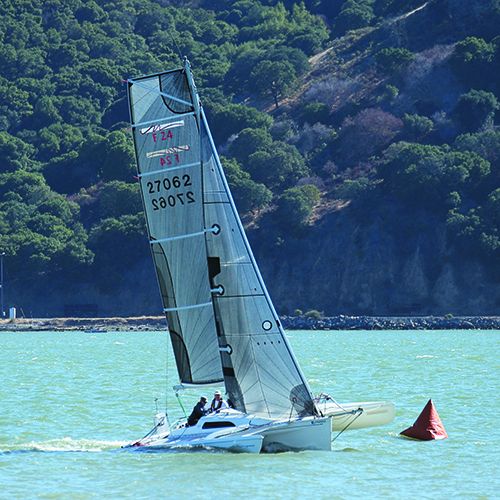
A deep, ballasted keel does a lot of good things. It lowers the center of gravity, provides lift to windward, and stabilizes the boat. It can add great strength if integrated into the construction of the hull, allowing the boat to sniff soft bottoms without damage.
There are downsides. Trailering is impractical. Countless shallow creeks and snug harbors become inaccessible. Docking is more expensive.
A centerboard is one solution, but there are differences. You probably read something about raising and lowering the centerboard or daggerboard in a book on dinghy sailing years ago, and unless you’ve been racing centerboard boats all these years, you’ve probably forgotten the details. Here’s a little refresher.
Even for the cruising sailor, centerboard position is as vital an adjustment, as sail balance and trim.
Balance. On a poorly trimmed boat, one of the largest sources of drag is often excessive rudder angle. Assuming you have the typical rudder profile (NACA 0021), the optimal helm range is generally 2-4 degrees when close hauled. A few degrees helps it share the work of the keel, providing lift to windward. More rudder angle and you are increasing drag, and if the angle exceeds 6 degrees, you are courting a stall when a strong turn to leeward is needed.
What causes excessive load on the rudder?
- Too much sail area aft. Sailing with main-only or a partially rolled-up genoa can do this.
- Over-trimmed mainsail.
- Excessive mast rake. Check the manual. Beach cats and planing skiffs have very specific reasons for radical mast rake. It only translates into more speed or better handling if the boat was designed for it.
- Excessive heel or bow-down trim. The hull form itself can force a turn to windward. A deeply buried bow can act like a forward rudder.
Centerboard trim
There are ways to fix these tendencies. Ease the main or lower the traveler. Reef the main and the headsail in balance. When sailing off the wind, it is often better to reef the main before the jib, to help keep her head down. Rake the mast to spec. Sail the boat flat. Bear away in the puffs when sailing deep, before the boat begins to heel excessively. Always steer for balance.
However, a centerboard or daggerboard adds an additional trim tool that is often forgotten. When the centerboard first begins to swing up, it moves more aft than up. In fact, a centerboard that is half up has typically lost only 20 percent of its draft and 15 percent of its projected area. On the other hand, the center of lateral resistance (CLR) on a 4-foot centerboard has moved aft about 1½ feet.
What about the change in righting moment of a weighted board? You have lifted it no more than 15 percent of the distance to the waterline, and depending on the board’s maximum depth, you’ve probably lost no more than 10 percent of the board’s contribution to righting moment. Don’t lift a weighted board more than this under sail, but experiment with how a slight movement aft changes things. Always mark the pendant so you know how far you have lifted the board.

Rising windspeeds
Consider the case of our Corsair F-24 test boat. As the wind rises, we might furl the jib for easier sailing. Reefing the main gives better balance, but rolling up the jib is easy and eliminates handling a whole set of sheets. Unfortunately, the sail center of effort (COE) then moves aft three feet, badly overloading the rudder.
In this situation, sailing becomes sluggish and we get trapped in irons every single time we try to tack. And there is no escape from irons, because even when we back the boat out as far as possible by reversing the rudder and fully easing the main sail—as deep as a beam reach—the moment we attempt to sheet in to make way, the bow swings right back into the wind.
However, if we lift the centerboard halfway, the center of lateral resistance moves aft about 1½-feet with very little change in area. We have less sail up, so the loss in area does not significantly increase leeway. The rudder will still be slightly overloaded and successful tacking requires easing the mainsheet as the boat comes through the wind, but you won’t be trapped in irons and the boat accelerates well as the main is slowly brought in. The rudder angle remains a little higher than normal, but it isn’t a brake.
Reaching in Strong winds
Strong reaching conditions are another time when centerboard adjustments help. When the wind gusts, the boat heels, and the resulting submerged hull form wants to turn to windward. In the case of a multihull, the lee bow digs in, acting as a forward rudder. The helmsman tries to bear off, but the rudder stalls and the boat swerves to windward anyway. Apparent wind accelerates, flow over the sails becomes better attached (reaching sails are often partially stalled, so rounding up attaches the flow), apparent wind increases, and power increases dramatically, just when you don’t want it. Centrifugal force from the rapid turn adds to the mess. A monohull will broach. A multihull can capsize.
The solution? First there are the standard solutions. Reef the mainsail early and fly more headsail; this will help keep her head down. Bear off early and smoothly before the boat heels excessively rather than waiting until the need is urgent. The earlier correction is actually faster, because the rudder angle relative to the water stays low, keeping drag low.
But also consider lifting the centerboard halfway or a bit more. Because there is little side force from the sails when reaching deep, you don’t need as much area. The boat will probably be moving faster through the water relative to the side force, generating more lift with less area. But don’t lift it all the way up unless the boat has a stub keel; you still want some board down as a leverage point for steering. The goal is to move the center of effort aft, so that the boat doesn’t want to round up.
You cannot adjust a board under load. If you apply enough force, you will only break something or hurt your back. Even if there are slides and a sturdy tackle, only adjust the board when traveling straight upwind or downwind, slowly if possible. This will reduce the load. Sometimes shooting straight into the wind for just a few moments is enough; quickly make the adjustment and then return to your original course.
Centerboard adjustments are not just for racers. It is a cruiser adjustment, just like reefing, for those who value good handling and safety. It’s all about balance, and by swinging the board aft just a little bit, you can cure certain handling problems.
RELATED ARTICLES MORE FROM AUTHOR
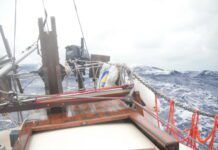
Responding to Emergencies: A Skipper’s Guide for Staying Calm

Sailboat Safety on Deck

Master the Sailing Basics: Never Stop Learning the Little Things
Leave a reply cancel reply.
Log in to leave a comment
Latest Videos

The Perfect Family Sailboat! Hunter 27-2 – Boat Review

Pettit EZ-Poxy – How to Paint a Boat

The Boat From True Spirit – Sparkman & Stephens

Top 5 Boat Hacks – Boat Maintenance Tips and Tricks
Latest sailboat review.

- Privacy Policy
- Do Not Sell My Personal Information
- Online Account Activation
- Privacy Manager

(215) 508-2704
- Tao Catamarans
- Dolphin Catamarans
- Voyage Catamarans
- Omaya Yachts
- All Pre-Owned Catamarans
- Exclusive TMC Catamarans
- Sold Catamarans
- Buying A Multihull
- Selling A Multihull
- Sailing Schools
- Yacht Charters
- TMC Newsletter
- Employment Opportunities
- Mission Statement
- Affiliations
Performance Study of Daggerboards Versus Keels
Story by Phillip Berman / August 17, 2018
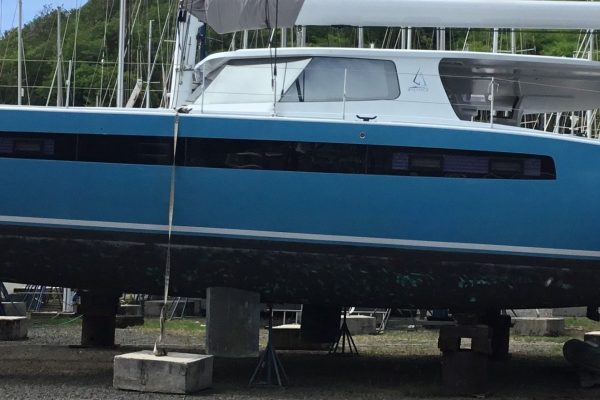
By: Phillip Berman, published with editor’s permission from Boating NZ and Blue Water Sailing
In my forty-five year career in the catamaran industry there’s been a relentless debate on the virtues and vices of daggerboards versus fixed keels. This debate has, however, mostly been waged without “hard numbers” from which to compare performance differences. As we have had requests at Balance Catamarans for both keels and daggerboards, Anton Du Toit (my design partner) and I felt we should conduct a study, the results of which follow.
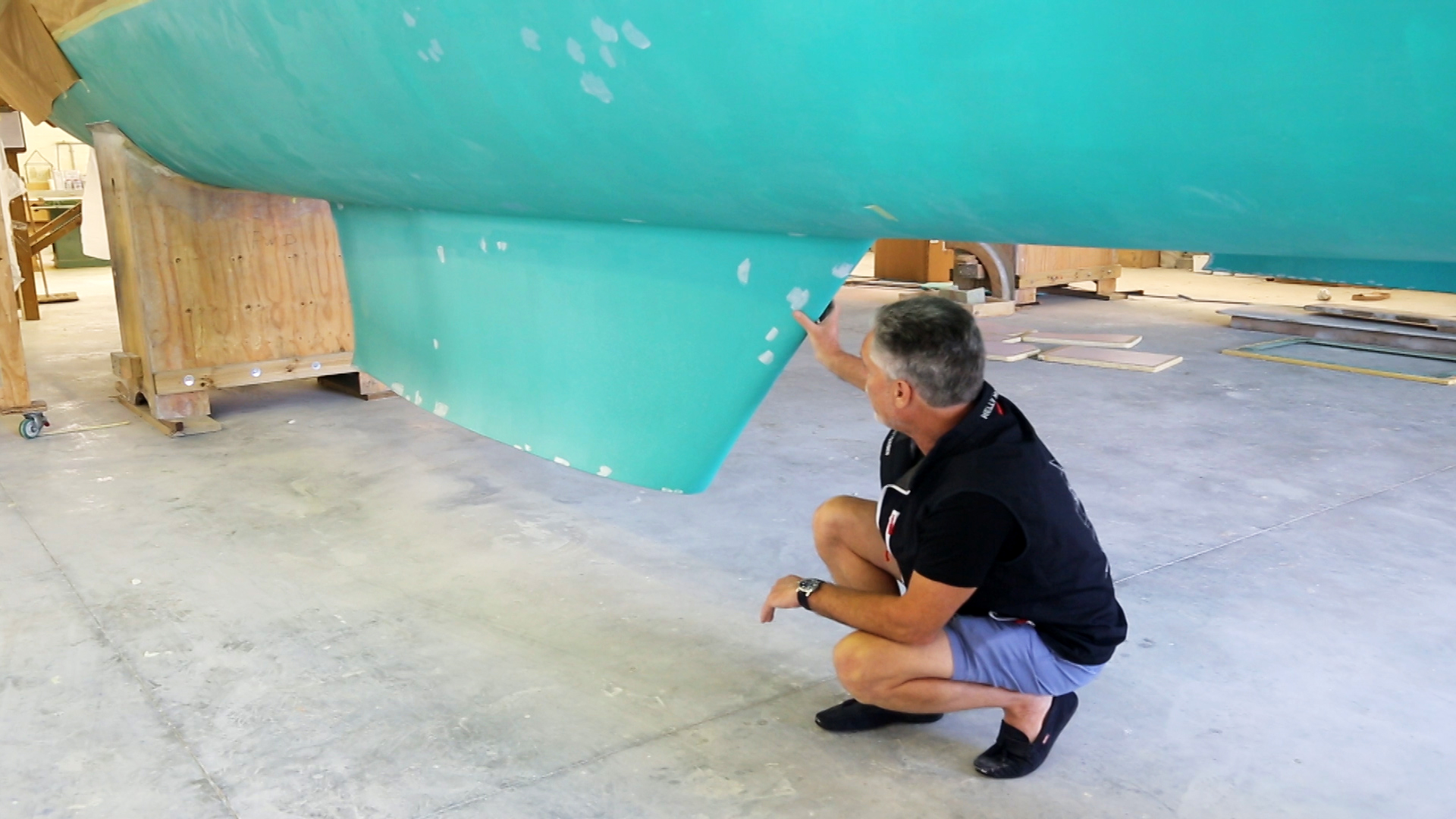
When we first set out to design and construct the Balance 526 we were aiming for cruising couples who wanted more performance and quality than they could find in mass production cats, but also more interior space, payload capacity and ease of use and maintenance than consumers focusing primarily on speed. Our intent was to find the balance – not to create the “lightest and fastest 52” in the world, or the “largest 52,” but a catamaran that could sail swiftly on all points of sail, carry significant levels of payload, yet still be gracious to live on. We also wanted her to be pleasing to the eye.
Our focus at Balance brings us an interesting range of buyers, some of whom are more focused on strength, space, safety and comfort rather than all out speed (cruiser types), others who are more speed focused, less value oriented, and prepared to give up comfort, ease of operation and payload capacity to go a bit faster (racer types). The later sorts of buyers are mostly what I affectionately call “spreadsheet guys.” (Full disclosure: I am not a spreadsheet guy. I am far more focused on how a boat lives, how tough she is, what she can carry, and how simple she is to sail and maintain without a professional crew.)
As we have gone along a few of our customers have asked if we would create the 526 with performance keels rather than daggerboards. They felt that the advantages of keels trumped the performance advantages of boards. We were happy to comply, so Anton set about to design high performance keels for the 526. (Note: On our 451, we only offer her with dual daggerboards and two shallow permanent fixed minikeels. On all other Balance designs it remains customer choice which configuration they wish to have.)
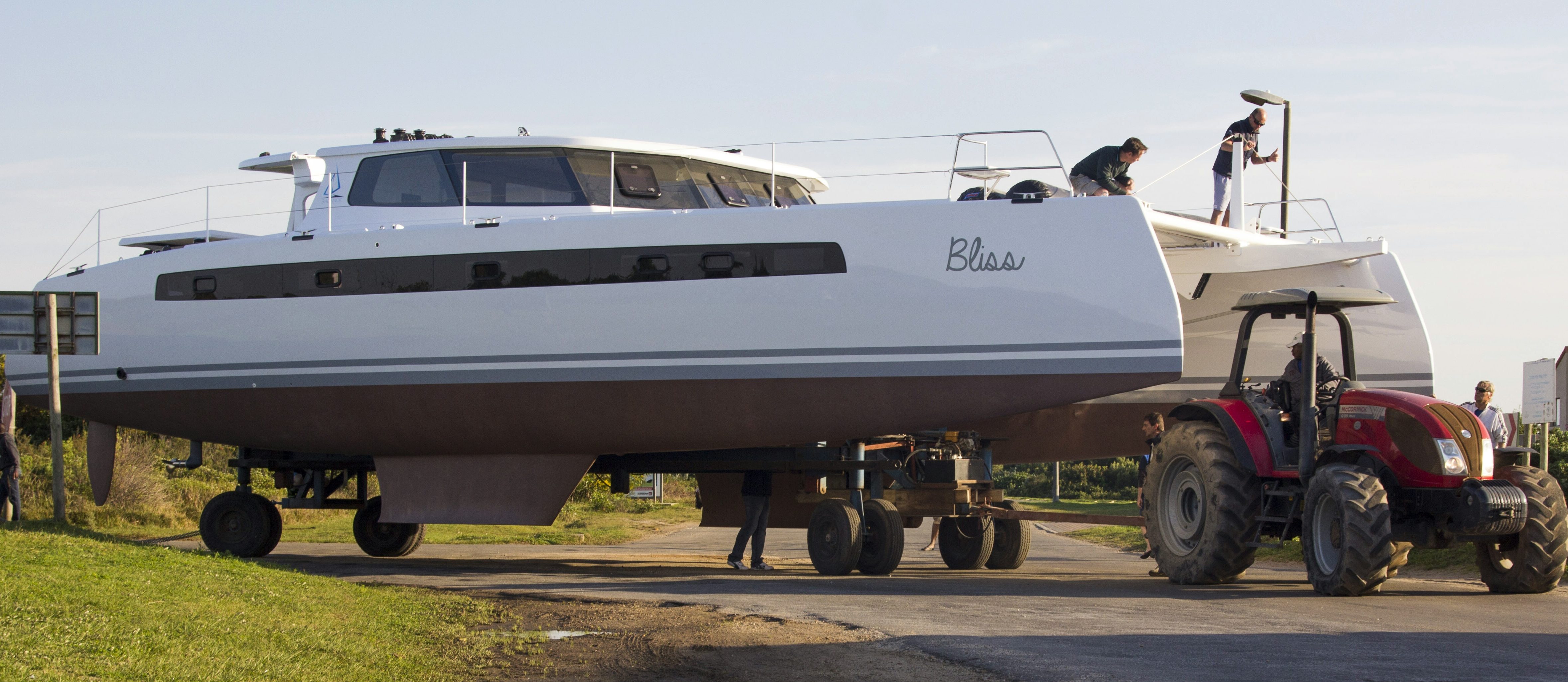
What we were not prepared to do was tell 526 buyers how much faster or slower the two different configurations would be. We felt it best to heed Lord Bryon’s advice to evade “kant and hyperbole” (the language of the day at boat shows!) so we hired the Wolfson Unit for Marine Technology and Industrial Aerodynamics at the University of Southampton to conduct comparative studies of the two configurations on identical 526 models. When you are comparing identical products with just two different variables it seemed a worthwhile study to undertake and share with our customers. It also becomes, to some extent, a worthwhile study for anyone considering a new or used catamaran purchase who is curious how the two different configurations impact performance.
While Anton and I believe these studies can be used by consumers to compare the relative performance differences between boards and keels, it is important to note that the 526 is a very light, narrowhulled epoxy performance cat and the keels we install are considerably finer, deeper and more carefullyshaped than those found on mass production designs. Additionally, we conducted the study with the daggerboards in the fully down position on all points of sail to reduce the studies complexity. The daggerboarded 526 would be marginally faster than the study indicates off- the-wind with boards raised due to a further reduction of wetted surface.
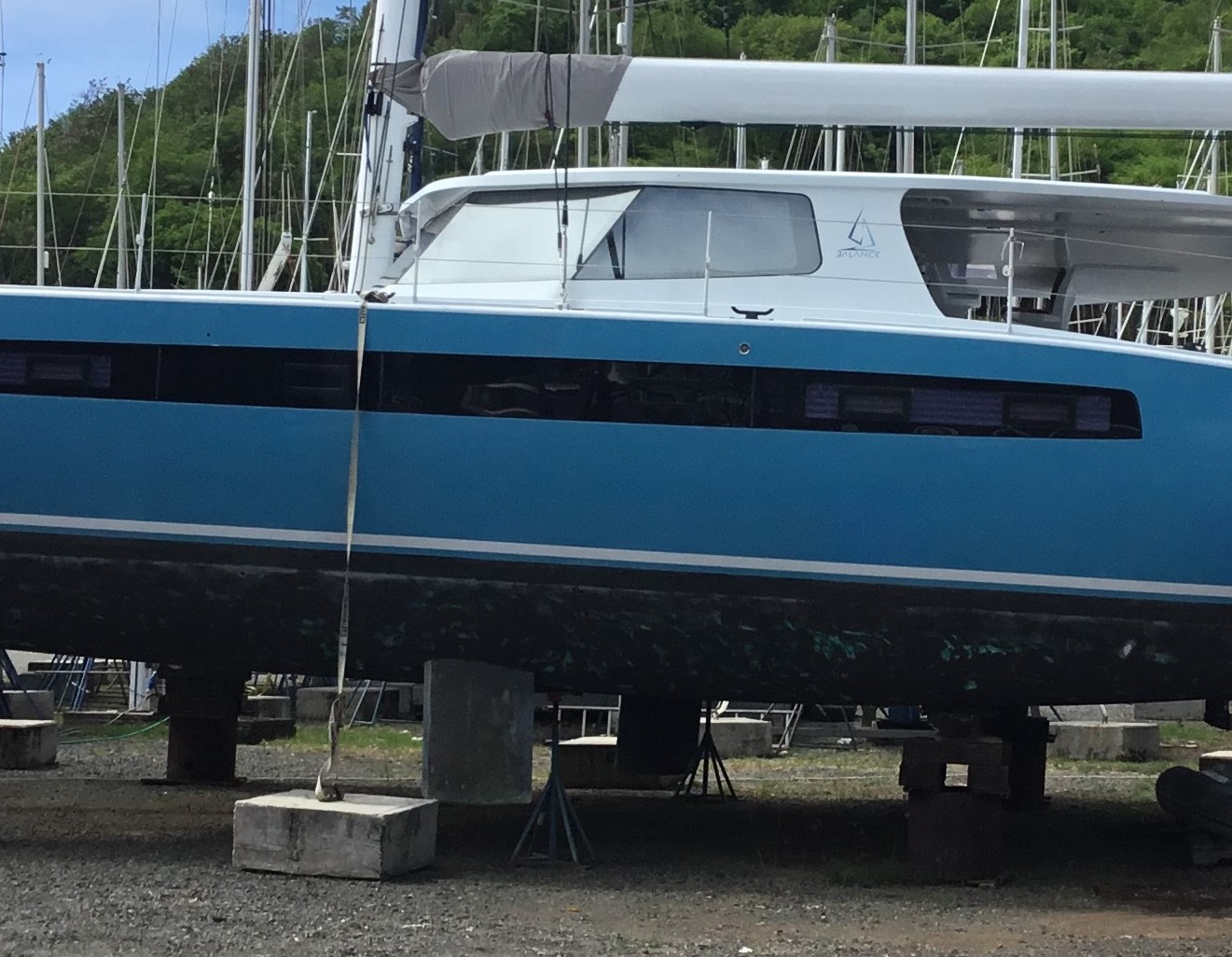
The disparity between keels and boards on a mass-production cat compared to a Balance or any other performance cat would be exaggerated considerably compared to the study that follows. I would note that we erred on the side of caution in setting our lightship weight for this study at 12.5 kg. We have carefully lode cell weighed our 5th boat and the actual lightship weight is 12,215 kg, or 26,930 pounds for the keeled 526 and 12,261 kg, or 27,030 pounds for the daggerboarded 526. Our lightship weight could be lower for customers prepared to put their boats on a diet, or sacrifice quality in several areas, but we have found that they want as much cabinetry as possible, folding tables, glass salon windows, Corian counter tops, and high-end flooring inside and out, etc. Spreadsheet guys miss the mark on this subject constantly in my experience. They also wrongly compare boats based on length, rather than the interior volume of the hulls and bridge – what I call the sum total of fiberglass parts. Regardless, the polars closely mimic the high performance our yachts have proven in real life cruising, fully laden, so this gives us great confidence in the studies accuracy.
Performance, of course, is not the be all and end all, so it is important to examine the advantages and disadvantages of boards versus keels beyond speed. They are as follows:
Advantages to Keels:
- No moving parts. One less thing to operate or break.
- If you ground the boat you hit the keels and they are easily repaired and at a low cost generally.
- You can chock the boat more easily on the hard and it is easier to beach in some circumstances.
- They cost less to fabricate.
- You get more room amidships for additional cabinetry.
- The keels add a bit of buoyancy. On a 526 about 1,600 pounds as our keels are large and mostly hollow inside.
- Daggerboards are typically a bit heavier. On the 526 each board and trunk weigh about 50 pounds more.
- Poorly designed boards and trunks can allow the boards to rattle when they are not under load. Keels do not rattle.
Advantages to Daggerboards:
- Boarded cats point higher and side-slip less as the study shows. I have noted that on keeled production cats you can “stick them up into the wind” but they tend to crab horribly when pinched, as such that you must crack off considerably to reduce leeway and sustain momentum. On most of the sea trials I conduct on production cats we “close reach” to windward on sea trials. This is less the case on deep, finely shaped performance catamaran keels.
- The draft on most keeled catamarans is deeper than the draft on daggerboarded cats. Our 526 keeled version draws about 12 inches more than the daggerboarded version. On daggerboarded cats the rudder tip usually represents her deepest draft. It is important to note that some cats carry very stubby keels to sustain shallower draft, but the shallower the keel the less well she performs when sailing close to the wind. This is important to keep in mind if you are comparing performance on fixed keeled production cats.
- Off the wind with the boards raised to 1/4 there is less drag and the boat steers and sails faster and more playfully.
- The daggerboarded cat is a bit faster and makes less leeway on nearly all points of sail as the study shows in the majority of wind conditions.
- An equally efficient set of keels have much more wetted surface than daggerboards, almost 4 times more. This is the case on our 526 keels.
- Daggerboards set properly can assist in preventing a cat from a “tripping capsize” in very high winds with large breaking cross seas. Both boards can be fully raised, or only the leeward board raised, so the boat can side-slip easily.
- Daggerboarded cats tend to have a bit higher resale value due to the fact that so few are produced in mass production. A buyer that wants boards will only focus on catamarans that have them.

Shifting our focus now to the performance data generated by Wolfson Unit. Their analysis returned the predicted boat speed and leeway angle for the Balance 526 with a keel design and daggerboard design for all combinations of true wind speed from 4 to 25 knots and true wind angles from 40 to 180 degrees. We can begin comparing these two configurations by directly comparing the speed and leeway at major points of sail, specifically beating, close, beam and broad reaching.
While beating the two designs are predicted to perform as follows: To summarize the upwind comparison, the daggerboard design is, on average, expected to sail 1.5 knots faster and 1.75 degrees higher. While close reaching the daggerboard design has less of an advantage than when beating, as can be seen from Table 2:
While close reaching the daggerboard design is expected to sail 0.5 knots faster and 0.75 degrees higher.
As the true wind angle approaches 90° for a beam reach, the keel and daggerboards become more closely matched.
In the beam reaching comparison the daggerboard design will sail slightly higher with a leeway advantage of about 0.25 degrees but it’s speed advantage in 5 knots TWS of 0.3 knots will fade to a 0.5 knot deficit in 16 knots TWS. At this point of sail the two designs are considered to have equal performance as the differences in leeway and boat speed are negligible.
Finally, while broad reaching the following speeds and leeway’s are expected.

In summary, when broad reaching the daggerboard design regains a slight advantage, as it maintains an additional 0.5 knots of boat speed. Leeway differences are again negligible.
Considering the above analyses, it can be seen that the daggerboard design will typically not only outperform the keel design but also out point it, make less leeway close to the wind, therefore giving the daggerboard design a substantial advantage when racing, or for performance focused sailors.
This data gives a fair comparison of the two designs at specific true wind speeds and angles but in order to fully understand the performance trends and enable better predictions between them, one must consider the entire range of wind conditions and all points of sail. This is best done with the use of speed and leeway deltas, where the differences between the two designs are calculated and analyzed.
The following two figures display the average speed and average leeway deltas. The calculation process to determine the deltas is chosen such that a positive value for the delta indicates an advantage for the daggerboard design, and a negative value favors the keel design. For example, a speed delta of +2 knots and a leeway delta of -1 degrees means that the daggerboard design is 2 knots faster than the keel design under the same conditions but would sail 1 degree lower than the keel design.
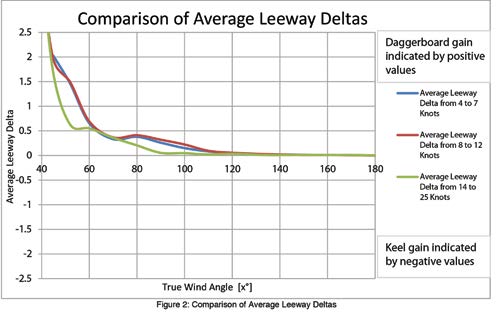
Counter to this, while still on a beam reach but when moving from a low wind condition to a high wind condition, the keel design begins to perform better. This is now taken from the green line (14 to 25 knot TWS range) and gives a -0.6 knot reading. Therefore the daggerboard design is now expected to be about 0.6 knots slower than the keel design under the new, higher TWS conditions.
Figure 2 is used in the same manner as Figure 1 but shows the leeway angle of each design rather than boat speed. Focusing again on a beam reaching condition, the leeway deltas indicate that the daggerboard will always out point the keel design as all three lines (TWS from 4 to 25 knots) indicate. positive values of 0.3, 0.35, and 0.1 degrees at 90 degrees TWA. Overall, Figure 2 shows that the daggerboard design has a significant gain in leeway over the keel design at all wind speeds and angles. This reaches a maximum when beating (TWA ±40-45 degrees) of 2 degrees, and declines to zero when running (TWA ±180 degrees).
With respect to the average boat speed deltas, Figure 1 shows that the daggerboard maintains a higher boat speed when sailing in light and medium winds (red and blue lines in Figure 1). In stronger conditions (green line) the daggerboards yield better boat speed when beating but the keel surpasses this between TWA of 60 to 145 degrees. Keeping in mind that the study was conducted with the daggerboards fully down at all times, in reality, the daggerboards will be raised in the 60 to 145 TWA range. As such the study slightly underestimates the speed of the daggerboard design over this TWA range.
Overall the daggerboard outperforms the keel in both boat speed and leeway in the vast majority of sailing conditions and is thus considered to be the better design choice if achieving ultimate performance is the key criteria. It should be noted that this study is specific to the Balance 526, but corresponding trends can be expected in performance cats of similar size and design.
In the end, and it is a point I cannot stress enough to any boat purchaser, all boats are sets of compromises and trade-offs, and so too with features – helm designs, sheeting systems, rig layouts, bimini designs, bed designs and locations, baths, engine placement, etc. Because I have been deeply involved in brokerage catamaran sales much of my life I recognize there is no one right or wrong boat, certainly no perfect boat, only a boat that happens to be a better fit for a particular sailor and his or her budget, cruising agenda and specific aesthetic proclivities.
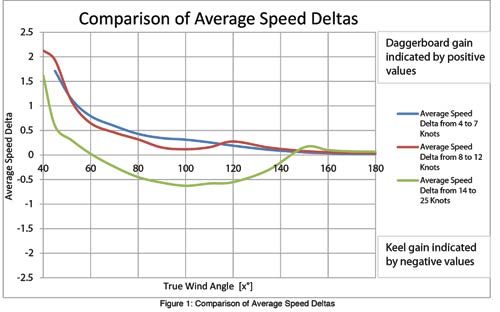
At least now we can say that if someone wants a 526 with keels, here is how she will perform compared to a boarded version. It is then up to the buyer to decide which configuration is the most appealing to them. I will say that, based on the five 526 we have sailing today, with over 60,000 miles of sailing behind them, those owners with keels seem quite happy, just as those with boards.
Alright spreadsheet guys, here’s your numbers to mess with!
Phil Berman is a former Hobie Cat World Champion and the founder of The Multihull Company, a global catamaran yacht brokerage firm. He is also the owner of Balance Catamarans, a boutique brand of high-end performance voyaging catamarans. He can be reached at [email protected] .
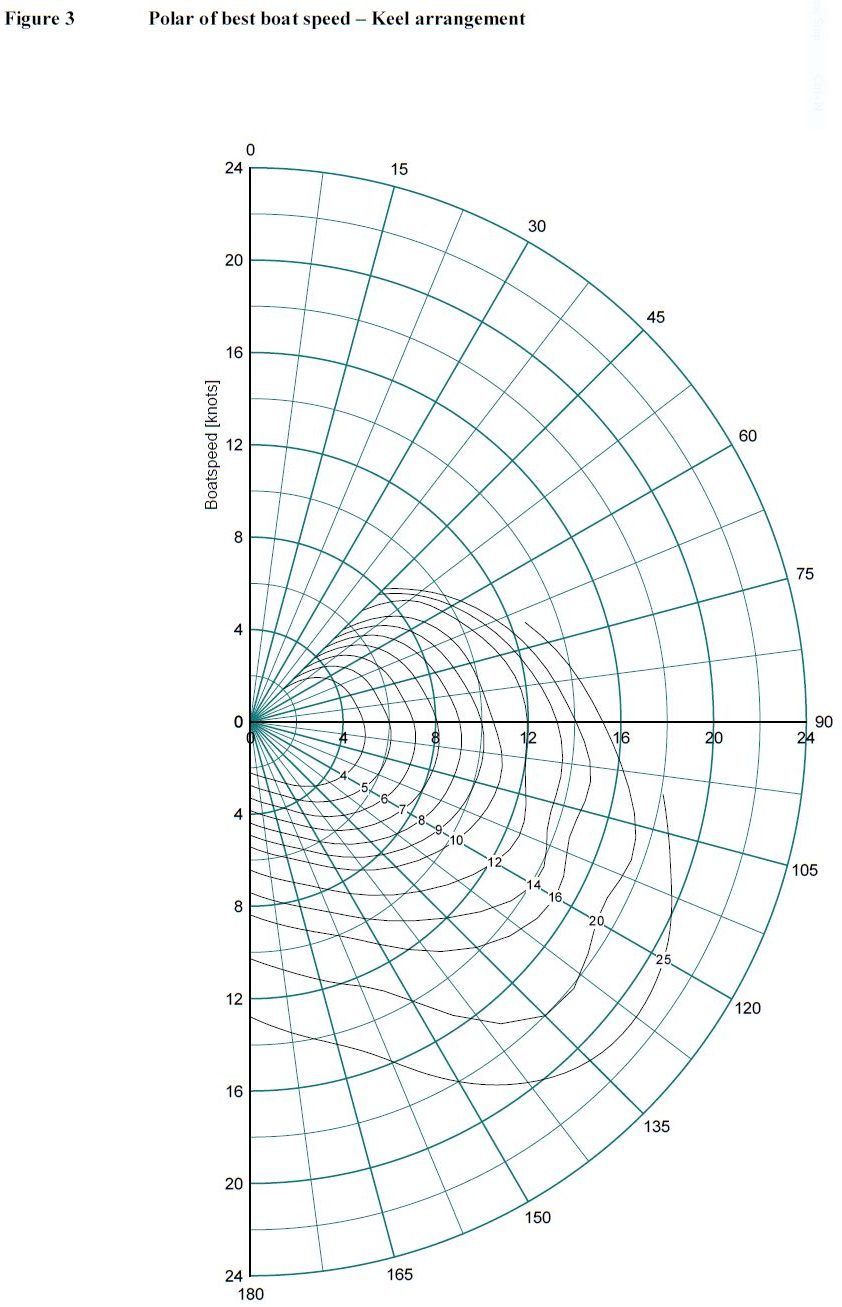
About Phillip Berman
- Are you a Spreadsheet Guy?
- Balance Catamarans is Born: A Bold Move in a Challenging Market
- Can a catamaran really sail upwind?
- Catamaran Depreciation
- Catamaran Vs Monohull
- Daggerboards vs. Keels
- Lessons Learned From A Free Spirit
- Placing a Boat Into Bare Boat Charter
- Post Survey Negotiations
- Saildrives or Straight Shafts? Which is Best For Me?
- Seller's Guide To Yacht Sales
- The 14 Biggest Mistakes When Purchasing a Used Catamaran and How to Avoid Them
- The 14 Biggest Mistakes When Purchasing a Used Cat…and How to Avoid Them Part Two
- The Perils of Internet Catamaran Shopping
- The Ten Commandments of Buying a Catamaran
Recent Posts
- The Multihull Company Opens A New Office On Florida's Gulf Coast
Sailing the Tao 452
The multihull company announced as distributor for omaya yachts, the multihull company announces the sale of the first pre-owned balance 482.
- Introducing the Tao 452: On Display At The Annapolis Boat Show October 12 - 15, 2023
Join Us At The Annapolis Boat Show Aboard the Voyage 590
The multihull company announced as dealer for the voyage 590, 6 great starter catamarans.
- Ian Edmonson Joins TMC As Yacht Broker in Fort Pierce, FL.
- The Multihull Company Opens New Office in Virginia
Categories: Articles , Articles by Phil Berman , Balance Catamarans , Catamaran Handling , Cruising Lifestyle , Design and Construction
Recent News
The multihull company opens a new office on florida’s gulf coast.
The Multihull Company is pleased to announce that Josie Tucci has joined its team of expert yacht brokers in the Gulf Coast. Josie brings over 25 years of experience in the marine industry, with a strong focus on catamarans.Josie's career began in France with Dufour Yachts, where she honed her sales and marketing skills. She then transitioned to the US,...
Join Multihull Company Broker Captain Conor Dugan as he takes the helm aboard ‘Moxie’ in the azure waters of the Bahamas, to see how the Tao 452 performs under sail with a full cruising payload. https://youtu.be/V2scHvqn5vI?si=kuLwjFCYQdFj0_KW
The Multihull Company is thrilled to announce its appointment as the exclusive distributor for Omaya Yachts, an exciting new brand of Power Catamarans built with precision at the esteemed Elica Yard in Silastra, Bulgaria. This exciting new partnership further solidifies The Multihull Company's position as a premier distributor in the maritime industry, offering clients unparalleled access to cutting-edge vessels designed...
In early 2023, Cruising World approached us to seek our opinion on recommending a couple of brokerage catamaran options for first time catamaran buyers to consider when they first stepping into the catamaran market. Here are six boats hand-picked by The Multihull Company’s president and CEO, Capt. Will Miller, as excellent choices for brokerage-catamaran seekers. These are all worth a...
The Multihull Company Named Exclusive Dealer for Dolphin Catamarans and their New Model, the Dolphin 380
The Multihull Company, the world’s leader in multihull sales and service is excited to announce that it has been named the exclusive dealer for Dolphin Catamarans, a premier builder of high-quality catamarans, and their newest model, the Dolphin 380, designed by Philippe Pouvreau. "We are thrilled to be working with Dolphin Catamarans again and to be able to offer their...
The Multihull Company is pleased to announce the closing on the Balance 482 "SeaLife" We wanted to take a moment and thank her new owners on their amazing new catamaran, and to also congratulate our team handling the sale. TMC agent Andrew Hodgdon successfully represented the buyers on the sale of the vessel, while TMC CEO Will Miller represented the...
Introducing the Tao 452: On Display At The Annapolis Boat Show October 12 – 15, 2023
The Multihull Company is thrilled to unveil the new Tao 452, an exciting addition to the world of blue-water performance cruising catamarans. Meticulously engineered and crafted to perfection, the Tao 452 is set to redefine the catamaran experience for sailors worldwide. If you've ever felt the need for more sailing performance from your current production charter catamaran or been disappointed...
The Multihull Company is excited to announce its participation in this year's Annapolis Sailboat Show. The event will be held from October 12 - 15, 2023 in downtown Annapolis, and The Multihull Company will be showcasing the exquisite Voyage 590 catamaran from Voyage Yachts. The Annapolis Boat Show is a highly anticipated annual event that brings together boating enthusiasts, industry...
The Multihull Company is pleased to announce their appointment as a dealer for Voyage Yachts and their new model – the Voyage 590! The Voyage 590 is being celebrated as the ultimate, luxury sailing catamaran with all the comforts of home surrounded by panoramic views of paradise. She maximizes luxury accommodation and comfort, with the performance and blue-water capability characteristic...
- Read All Articles
We take pride in our happy customers
Andrew Hodgdon helped us sell our last boat. He was dedicated, professional and helpful every step of the way. He made valuable suggestions for how to best show the boat and brought only serious buyers to see her. I would highly recommend Andrew if you are looking to sell or purchase a vessel.
— sailelcie
Andrew is extremely knowledgeable, honest, and a delight to deal with. He made our buying process as comfortable and easy as it gets.
— Ben Edkins
Outstanding company with professional subject matter experts. If I were to buy or sell cruising sailboat, particularly a catamaran, Andrew would be my go to broker.
Andrew Hodgdon worked diligently to sell our yacht. He is very knowledgeable and an experienced sailor and captain.
— Neil Kaminar
Andrew was a huge contributor, helping us inform ourselves on all aspects of our purchase and the beginning of new-to-us boat ownership. It was our first, so we needed the specific help, attention and advice he provided us, which helped make it great experience.
— John Randle
Trust & expertise about us.
Successful relationships cannot exist without it. At The Multihull Company we base every relationship on a firm commitment to earning and retaining our client’s trust.
Advice of any kind is valuable only when grounded in hard-won expertise. It too, must be trustworthy. Trust and expertise define the heart and soul of The Multihull Company. We are a team of skilled professionals who thrive on providing expert, trustworthy advice and service to catamaran and trimaran sailors around the globe.
Follow us @themultihullcompany
- Pre-Owned Sales
Global Locations
New England +1-267-324-9067
Philadelphia +1-215-508-2704
Virginia +1-757-407-2526
Annapolis +1-703-350-8160
Charleston +1-843-364-4123
Brunswick +1-937-243-2213
Saint Augustine +1-910-477-2508
Fort Pierce +1-340-473-7469
West Palm Beach +1-561-312-0010
Ft. Lauderdale +1-215-508-2704
Miami +1-513-677-5338
St. Petersburg +1 727-432-2739
Seattle-Tacoma +1-206-297-1151
St. Martin +590 690 58 66 06
Grenada +1-473-457-3245
Puerto Rico +1-787-379-7348
Panama +1-305-735-1661
Trinidad +1-868-680-8909
Croatia +385 95 849 8009
France +33 (0) 6 73 97 17 30
Australia +61 (0)7 5444 4822
© Copyright 2024 The Multihull Company. All rights reserved.

- Forums New posts Unanswered threads Register Top Posts Email
- What's new New posts New Posts (legacy) Latest activity New media
- Media New media New comments
- Boat Info Downloads Weekly Quiz Topic FAQ 10000boatnames.com
- Classifieds Sell Your Boat Used Gear for Sale
- Parts General Marine Parts Hunter Beneteau Catalina MacGregor Oday
- Help Terms of Use Monday Mail Subscribe Monday Mail Unsubscribe
Dagger Board vs Swingkeel
- Thread starter qcovefishing
- Start date Mar 19, 2009
- Macgregor Owner Forums
- Ask A Macgregor Owner
qcovefishing
What are the advantages and disadvantages between a daggerboard and a swingkeel. I am looking to buy a Mac 26 mostly because you can trailer it, I am very new to sailing and am unsure the differance between sailing a mac 26 with a swing keel vs sailing an older one with a centerboard?
The specs will say that all things equal, the D is slightly faster than the S. I think that there are enough other variables to overcome that. What I like most about the S is that the centerboard will kick up in shallow water.
Re:centerboard vs. daggerboard. I spent the better part of the day today sailing in water ranging from 3' to 15'. Most of it was in the 4 to 6 foot range. A centerboard that kicks up is ideal for my bay waters. I probably would have torn up a daggerboard. Just study your water you will be sailing in. I like the idea of a daggerboard but it just flat will not work where I sail.
Here's what the factory says about a dagger board vs. a swing keel. This is taken from the factory website and describes differences between the 26M and the 26X. "A DAGGERBOARD HAS REPLACED THE CENTERBOARD Better performance is the big reason for the change. Here are a lot more reasons. 1. LESS INTERFERENCE WITH THE INTERIOR A centerboard trunk presents a 16" high problem from the mast almost back to the steps. Unfortunately, this ridge dominates the interior plan, and made it essential to bring the seating structure on one side out beyond the centerline. This forces a dinette type of configuration, which makes it more difficult to have a good conversational type seating for a bunch of crew members. It also reduced the interior floor space (and thus moving around space) by a significant margin. The daggerboard trunk, which is partially hidden by the galley, eliminated these problems. 2. IMPROVED STRUCTURE The daggerboard trunk takes the full downward thrust of the mast to the keel of the boat. The daggerboard requires a much smaller opening in the hull, which helps reduce drag and keep structural weight down. 3. NO ELECTROLYSIS OR LEAKS The daggerboard requires no metallic parts below the waterline. There are no holes in the hull to leak, or pins to wear. 4. EASIER MAINTENANCE The retraction cable is less subject to wear, and it can be easily replaced. The board itself can be lifted out through the deck for cleaning, inspection or repair. Removal of a centerboard is a tougher job. 5. QUIETER AT AN ANCHORAGE. Daggerboards are a lot quieter and subject to less wear when the boat is moored or at anchor."
my .02... I have a daggerboard, and have not had problems w/ grounding. Last weekend I was sailing in 16knts w/ reefed main, and about 1.5-2' of daggerboard. she tracked fine. I do like the increased strenght and low maintence of the daggerboard. however there are some cabin and cockpit improvements on the later S models I do desire. D's are typically 1k or more less in price.
I have a swing centerboard, and like Beamreach, I sail where it's occasionally too shallow for the board all the way down. It's very nice to have the board pivot up and then drop down. The big downside seems to be increased maintenance. Eventually, you'll probably have to replace the pivot bolt. There have been a lot of postings about that over the last few years. If I were in your position, I'd probably make the decision based on whether I sail in shallow water. If not, I'd probably favor the daggerboard.
This all depends on what 1 drinks, I drink Gin, and sometimes forget to tell the wife to riaise the centerboard, so for me and my 26s, this is a good thing,
Capt. Kermie
Although the daggerboard does not kick up like a centerboard, it raises and lowers easily for shallow water. I have my daggerboard line marked where it holds the daggerboard at the same depth as the rudders for navigating shallow waters. I am not usually travelling at a very high speed in shallow waters so if the daggerboard does ground it will be at a very slow speed and I would rather be stopped by a stronger daggerboard than have the weaker rudders hit and possibly break. The daggerboard can be raise or lowered to as many increments as one wants along its' depth, there is no leaving it permanently lowered all the way down as some would imply. There is nothing wrong with a daggerbaord, it has its' own advantages.
- This site uses cookies to help personalise content, tailor your experience and to keep you logged in if you register. By continuing to use this site, you are consenting to our use of cookies. Accept Learn more…
Great choice! Your favorites are temporarily saved for this session. Sign in to save them permanently, access them on any device, and receive relevant alerts.
- Sailboat Guide
2010 MacGregor 26M
- Description
Seller's Description
The MacGregor 26M is a dagger-board equipped fractional sloop motorsailer for those who wish to have the ability to outrun a change in the weather or return to port quickly after a leisurely day under sail.
Thanks to the detachable, hinged mast with a system for single-handed raising, lowering and securing for transport, the lack of a fixed deep keel, tilt engine and rudders, the boat can be trailered on conventional bunk or roll-on trailer.
Under sail, the boat can make 7 MPH and under power the 60 HP Evinrude E-TEC outboard will enable the boat to plane at over 20 MPH, and with 24 gallons of fuel, it will do that for quite a distance.
At the pedestal wheel helm is the throttle / shift for the engine, keyed ignition, a remote for the VHF transceiver, Garmin GPS mapper and autopilot.
Down below are for and aft berths, a head with porta-potty, a dinette, sink and storage compartments, enough to sleep and provision at least four.
The MacGregor 26 is a very popular boat, first introduced in 1986, with five thousand being produced in various variations since, this model, the 26M, was produced from 2002 until 2013.
Rig and Sails
Auxilary power, accomodations, calculations.
The theoretical maximum speed that a displacement hull can move efficiently through the water is determined by it's waterline length and displacement. It may be unable to reach this speed if the boat is underpowered or heavily loaded, though it may exceed this speed given enough power. Read more.
Classic hull speed formula:
Hull Speed = 1.34 x √LWL
Max Speed/Length ratio = 8.26 ÷ Displacement/Length ratio .311 Hull Speed = Max Speed/Length ratio x √LWL
Sail Area / Displacement Ratio
A measure of the power of the sails relative to the weight of the boat. The higher the number, the higher the performance, but the harder the boat will be to handle. This ratio is a "non-dimensional" value that facilitates comparisons between boats of different types and sizes. Read more.
SA/D = SA ÷ (D ÷ 64) 2/3
- SA : Sail area in square feet, derived by adding the mainsail area to 100% of the foretriangle area (the lateral area above the deck between the mast and the forestay).
- D : Displacement in pounds.
Ballast / Displacement Ratio
A measure of the stability of a boat's hull that suggests how well a monohull will stand up to its sails. The ballast displacement ratio indicates how much of the weight of a boat is placed for maximum stability against capsizing and is an indicator of stiffness and resistance to capsize.
Ballast / Displacement * 100
Displacement / Length Ratio
A measure of the weight of the boat relative to it's length at the waterline. The higher a boat’s D/L ratio, the more easily it will carry a load and the more comfortable its motion will be. The lower a boat's ratio is, the less power it takes to drive the boat to its nominal hull speed or beyond. Read more.
D/L = (D ÷ 2240) ÷ (0.01 x LWL)³
- D: Displacement of the boat in pounds.
- LWL: Waterline length in feet
Comfort Ratio
This ratio assess how quickly and abruptly a boat’s hull reacts to waves in a significant seaway, these being the elements of a boat’s motion most likely to cause seasickness. Read more.
Comfort ratio = D ÷ (.65 x (.7 LWL + .3 LOA) x Beam 1.33 )
- D: Displacement of the boat in pounds
- LOA: Length overall in feet
- Beam: Width of boat at the widest point in feet
Capsize Screening Formula
This formula attempts to indicate whether a given boat might be too wide and light to readily right itself after being overturned in extreme conditions. Read more.
CSV = Beam ÷ ³√(D / 64)
Replaces the MACGREGOR 26X. Twin rudders and rotating spar. As with the previous model, designed for use with a more than ‘auxilary’ sized outboard. Capable of 22 mph under power. Under sail she can carry an additional 1150 lbs. of water ballast.
This listing is presented by PopYachts.com . Visit their website for more information or to contact the seller.
View on PopYachts.com
Embed this page on your own website by copying and pasting this code.
Similar Sailboats For Sale

2012 MacGregor 26M

2007 MacGregor 26M

2005 Macgregor 26M

2005 McGregor 26M

2007 Macgregor 26M

2011 MacGregor 26M

2006 Macgregor 26M

2009 MacGregor 26M
- About Sailboat Guide
©2024 Sea Time Tech, LLC
This site is protected by reCAPTCHA and the Google Privacy Policy and Terms of Service apply.
10% Off Hobie Parts / 15% Off Rigging / 10-15% Off Select Kayaks - SHOP NOW

- Call Us +1-503-285-5536
- Sign in & Register
- Recently Viewed
- One Design Parts
Rudders & Daggerboards
Rudders, tillers, dagger boards, and hardware for Optimist sailboats. Includes rudders, daggerboard tillers and tiller extensions including epoxy race blades, Deluxe tillers, Tiller Universals, gudgeons, pintles and more. Enjoy FREE SHIPPING on qualifying orders.
- Qty in Cart

Opti Rudder w/ Tiller and Extension (Fighter)

Opti Daggerboard - Flex (Fighter)

Opti Daggerboard - Medium (Fighter)

Opti Rudder (Fiberglass)

Opti Daggerboard (Fiberglass)

Opti Blade Set (Fiberglass)

Opti Gudgeon Set
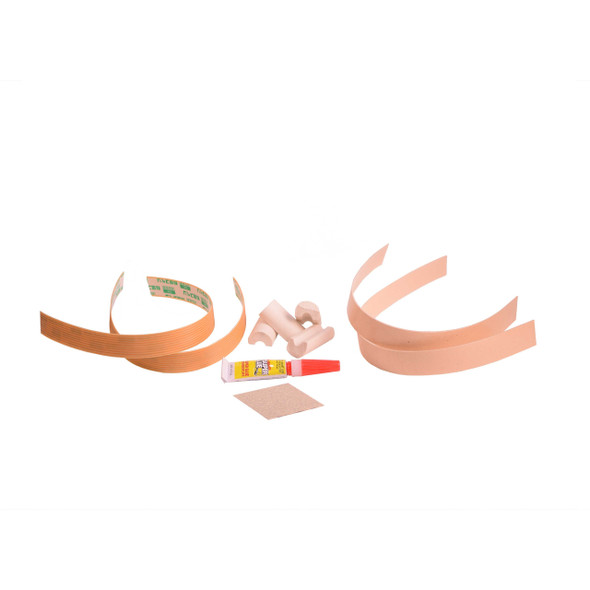
Opti Daggerboard Protection Kit

Opti Rudder Mounting Hardware

Opti Rudder Fittings Set

Opti Pintle Set

Opti Daggerboard Slot Insert

Opti Daggerboard Bungy w/Handle

Opti Rudder Retaining Clip
- Total: items /
- Add all to cart
Adding your products to cart
Subscribe to our newsletter.
Sign up for our newsletter to receive exclusive discounts, new product announcements, and upcoming sales.
Choosing a Centerboard or Fixed Keel Sailboat
- Snowboarding
- Scuba Diving & Snorkeling
Centerboard or Fixed Keel?
You need to consider many different questions when deciding what kind of sailboat is best for you .
Depending on the general size range of the sailboats you may be interested in, you may need to choose between fixed-keel boats and centerboard (or swing keel or daggerboard) boats. This article will help you choose which is best for your needs.
As only a very general rule, most sailboats over 20-something feet have fixed keels. Most sailboats under 15 feet or so have centerboards. But there is a wide range of boats from 12 to about 25 feet with either a fixed keel or a centerboard. For example, in this photo, the boat on the left has a fixed keel, while the boat on the right, of about the same size, has a centerboard.
If you are shopping for a sailboat in this range, you should understand the differences between these fundamental types of keels.
Fixed Keel Sailboats
Virtually all large racing and cruising sailboats have a fixed keel. A keel is needed to keep the boat from being blown sideways at all points of sail except downwind. A keel also provides weight low under the water to lower the boat’s center of gravity below the waterline, which is needed so that the boat bobs back upright if knocked over by wind or waves.
Sailboats have many different types of fixed keels , such as full keels (see photo) and fin keels. If you decide a fixed keel boat is best for your sailing purposes, consider also which type keel best meets your needs.
Centerboard Sailboats
On centerboard sailboats, the centerboard functions like a keel to keep the boat from being blown sideways. (All sailboats need a keel of the board for this reason: the narrow, flat surface of the board or keel produces little drag when the boat moves forward but resists motion sideways.)
The centerboard usually hangs down below the hull from a pivot at one end. It can be raised by pulling a line that swings the centerboard up into a centerboard trunk along the center of the boat, as shown in the photo.
Some small boats, like a Sunfish, have a removable daggerboard rather than a centerboard. The daggerboard has the same function, but rather than swinging down, it is inserted like a blade down through a slot in the hull to protrude like a thin keel below the hull. A swing keel is another term used for a type of keel that like a centerboard can be raised.
A centerboard may or may not be weighted. If the centerboard is weighted, then it also provides weight low in the water, like a keel, to help keep the boat upright (although not as much weight as a fixed keel can supply). If the centerboard is not weighted, like the fiberglass centerboards of many small sailboats, then sailors must keep the boat upright by positioning their own weight on the upwind side of the boat.
Benefits and Disadvantages of Fixed Keel and Centerboard Sailboats
Fixed keels and centerboards each have their own benefits but also disadvantages. When deciding what type of boat to buy, be sure you have considered these differences:
Advantages of a Fixed Keel:
- Provides the most ballast to resist capsizing and ensure recovery from a capsize
- More effective at preventing leeway (sideways movement of the boat)
- Crew do not have to position body weight to prevent capsizing (see photo)
- No centerboard moving parts to break or jam
Disadvantages of a Fixed Keel:
- With deeper displacement, the boat cannot enter shallow water
- The boat is heavier for its size (usually an issue only when trailering)
- With deeply fixed keels, the boat may not fit on a trailer at all (25 feet is typically the largest trailerable fixed keel sailboat) - requiring the inconvenience and expense of a boatyard for launching, haulout, and storage
Advantages of a Centerboard:
- The centerboard can be raised to decrease displacement to allow the boat into shallower water – and it should swing up and back if it hits the bottom when sailing with it down
- The centerboard can be raised for faster downwind sailing
- The centerboard can be partially raised if needed to provide better boat balance
- Most centerboard boats can be trailered and easily launched and hauled out on boat ramps (larger centerboard boats may require deeper ramps)
A popular trailerable centerboard sailboat is the MacGregor 26 , which with its water ballast has the advantages of centerboard boats but not all the disadvantages.
Disadvantages of a Centerboard:
- Provides no (unweighted board) or less (weighted board) ballast, compared to a fixed keel, to resist capsizing and ensure recovery from a capsize
- Less effective than a larger fixed keel at preventing leeway (sideways movement of the boat)
- The centerboard trunk takes up space in the boat’s cockpit or cabin
- The centerboard pivot and control line involve moving parts and can jam or break
Finally, some historic crafts have leeboards instead of centerboards; these boards, mounted outside the hull on both sides, can be pivoted down like a centerboard to resist leeward motion. And some sailboats have fixed keel-centerboard combinations, which provide ballast and prevent leeward motion even when the centerboard is up but also provide the option to attain less leeward motion sailing upwind when the board is down.e a centerboard to resist leeward motion. And some sailboats have fixed keel-centerboard combinations, which provide ballast and prevent leeward motion even when the centerboard is up but also provide the option to attain less leeward motion sailing upwind when the board is down.
- Choosing an Inboard or Outboard Engine
- Learn How to Sail a Small Sailboat – 1. The Parts of the Boat
- Buying a Used Boat Online
- Control Your Tiller Without a Tiller-Tamer
- The Types of Sailboat Rudders
- How to Heave To a Sailboat
- Using AIS on Your Sailboat
- How to Anchor a Sailboat
- How to Tow a Dinghy Behind a Sailboat
- The Sunfish: A Perfect Lake or Urban Sailboat
- Tricing Pendants and Lifeboat Rigging
- How to Raise the Mainsail
- How to Gybe a Sailboat
- Best Sailing and Boating Apps
- When to Adjust Sailboat Sails for Stronger Winds
- How to Boat

Your shopping cart is empty!
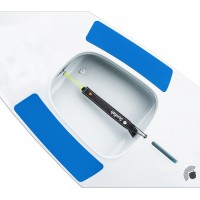
Sunfish Direct, Topside Non-Skid Padding, Blue, SUN-21032
Upgrade your Sunfish with 5mm PE/EVA foam, a superior choice over marine carpet and traditional mold..
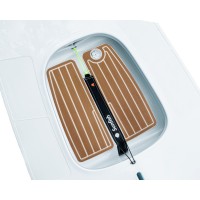
Sunfish Direct, Cockpit Floor Non-Skid Padding, Teak, SUN-21056
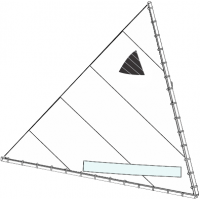
ISCA, North Race White Sail, SUN-10014
The Sunfish Racing Sail (White) is built with the racer in mind. These sails use a slightly lighter ..
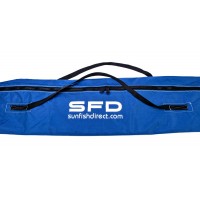
Sunfish, Spar Bag, 87132
The Sunfish Spar bag is a durable bag designed to store and protect Sunfish spars. The Sunfish spar ..

- The Sunfish is the most popular boat ever produced!
- Great for both casual sailing and racing. Explore lakes, bays, even oceans.
- Compact, lightweight, easy to transport. Ideal for one or two sailors.
- We offer customization options you won't find anywhere else!
- We have a large selection of boats, sails and parts in stock and ready to ship.

Configure your boat!
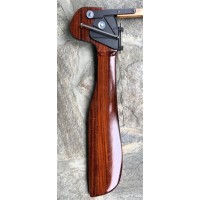
AeroSouth, FS Wood Rigged Rudder, Sunfish, FS-RDD-BLD-FOR-RIG
Improve the speed and handling of your Sunfish Sailboat with the fully rigged FS Rudder Blade. Made ..
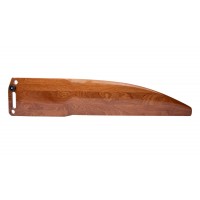
AeroSouth, Sabre Daggerboard, Sunfish, SBR-DGG-FOR-SNF
Improve the speed and handling of your Sunfish Sailboat with a Sabre Daggerboard. Made of laminated ..
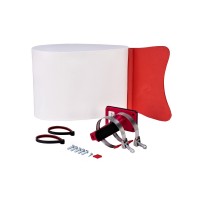
AeroSouth, Sunfish Dinghy Bob, DNG-BOB
Dinghy Bob prevents your small sailboat from turning-turtle and getting its mast or spar stuck in th..
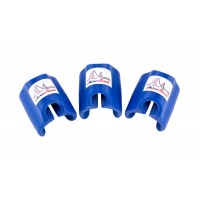
AeroSouth, Sunfish Mainsheet Hanger Clip (Set of 3, Blue), SNF-MNS-HNG-CLP-B
Set of three Sunfish mainsheet hanger clips. Made of durable PETG plastic. Fitted for the 1.5" diam..

IMAGES
COMMENTS
A daggerboard is a removable vertical keel that is inserted through a "trunk" in the center of a vessel's hull, usually amidships. Daggerboards are usually found in small sailing craft such as day sailers, which are easily handled by a single person. Daggerboards are not usually ballasted but are locked in place by a clip or pin.
Some Common Centerboard and Daggerboard Designs. We'd left Clearwater that morning and were now headed north, a mile or so off the barrier islands protecting St. Joseph Sound. To me, the obvious way to get closer inshore was via the channel immediately south of Anchor Key. Not only were the soundings a good 8ft or more, but there was a well ...
On a sailboat, the difference between a daggerboard and a centerboard is how they are moved into position. A daggerboard is lifted and raised vertically (up and down) through a slot in the hull; a centerboard, on the other hand, pivots or swings into place. That was the short answer.
9) When the speed increases, it is worthwhile raising the windward board to optimize drag. Note: a daggerboard which moves is no use. Therefore we raise it! 10) But for safety, it is preferable to raise the leeward appendage: in the case of a strong gust, the risk of the boat 'tripping up' is thus reduced.
By positioning the daggerboard at an angle, the skipper can reduce the amount of leeway the boat experiences, allowing it to maintain a more consistent course. Overall, daggerboards are a key component of sailing catamarans and can have a significant impact on the performance of the boat.
Ultimately, whether you opt for a sailboat equipped with a daggerboard system or one featuring a centerboard mechanism depends on various factors, including performance goals, sailing preferences, and intended use. Don't hesitate to consult with experienced sailors, boat designers, or reputable manufacturers to ensure you make the right choice.
The daggerboard is the heart of a multihull. You can have the slipperiest of hulls, lightest of boats and most expensive rig, but if you don't have this part of the boat right, you are not getting good returns on the money spent in the other areas. It doesn't matter if you are racing or cruising, the ability to go to wind makes or breaks a ...
How to build a simple Centerboard / Daggerboard for a sailboat. 15 foot Chrysler Mutineer. I bought a Mutineer hull. It is a small 15 foot sailboat, ...
A daggerboard is a retractable centerboard used on sailboats to prevent lateral movement. Daggerboards can have various shapes, including straight, curved, or asymmetrical designs. The shape of the daggerboard affects its efficiency in reducing side slippage and improving sailing performance.
A daggerboard sailboat is a type of sailing vessel equipped with a retractable centerboard, known as a daggerboard, that provides stability and prevents sideways drift. This design allows the boat to navigate shallow waters while still maintaining its speed and maneuverability in various wind conditions. Navigating the Seas: An Introduction to ...
Boat weight, weight distribution, sail area, wind strength, sea state, sail trim are all things that effect the decision for how to use the daggerboards: how much daggerboard to use and which one (or both) to use.
This catamaran instructional video teaches you how to Use daggerboards on a catamarancome and learn to sail with us! www.adventuresailing.com.au
Understanding the difference between centerboards and daggerboards can help you make an informed decision when selecting a sailboat or when considering modifications to your current vessel. If you're sailing a catamaran with daggerboards, you'd raise the daggerboard on the leeward hull while fully extending the upwind daggerboard.
Daggerboards add performance to a catamaran. In doing so they are subject to incredible side forces to stop the boat slipping to leeward and providing lift. A straight daggerboard not only stops leeward slippage but also provides lift to windward because the water flowing over the board has a high pressure and low pressure side, much like an ...
And if fitted on a chine-design boat that does not need a super-effective foil for lateral resistance, the overall result can be excellent. Sections through a daggerboard or foil should be fair and consistent and as an aerofoil, have the maximum thickness about 30% of the way back, with a nose radius of approximately 1/4 the max. board width.
Since 1974, Practical Sailor's independent testing has taken the guesswork out of boat and gear buying.
Catamaran daggerboard pros and cons breakdown compared to a fixed keel Catamaran. Written by New England Catamaran broker Derek Escher.
With respect to the average boat speed deltas, Figure 1 shows that the daggerboard maintains a higher boat speed when sailing in light and medium winds (red and blue lines in Figure 1). In stronger conditions (green line) the daggerboards yield better boat speed when beating but the keel surpasses this between TWA of 60 to 145 degrees.
The daggerboard does not have a safety fuse integrated into the line driver since they are vertically lifted. If a daggerboard struck an object it would endure the full impact force and transfer the load to the bearing box which would result in higher levels of damage to the board or even the boat. Daggerboards also require real estate in both port and starboard hulls penetrating into the ...
The daggerboard trunk takes the full downward thrust of the mast to the keel of the boat. The daggerboard requires a much smaller opening in the hull, which helps reduce drag and keep structural weight down.
The MacGregor 26 is a very popular boat, first introduced in 1986, with five thousand being produced in various variations since, this model, the 26M, was produced from 2002 until 2013. Advertisement. Specs. Designer Roger MacGregor Builder Macgregor Yacht Corp Associations? # Built? Hull Monohull Keel Daggerboard Rudder? Construction
Rudders, tillers, dagger boards, and hardware for Optimist sailboats. Includes rudders, daggerboard tillers and tiller extensions including epoxy race blades, Deluxe tillers, Tiller Universals, gudgeons, pintles and more.
Depending on the general size range of the sailboats you may be interested in, you may need to choose between fixed-keel boats and centerboard (or swing keel or daggerboard) boats. This article will help you choose which is best for your needs. As only a very general rule, most sailboats over 20-something feet have fixed keels.
AeroSouth, Sabre Daggerboard, Sunfish, SBR-DGG-FOR-SNF Improve the speed and handling of your Sunfish Sailboat with a Sabre Daggerboard. Made of laminated .. $350.00